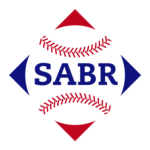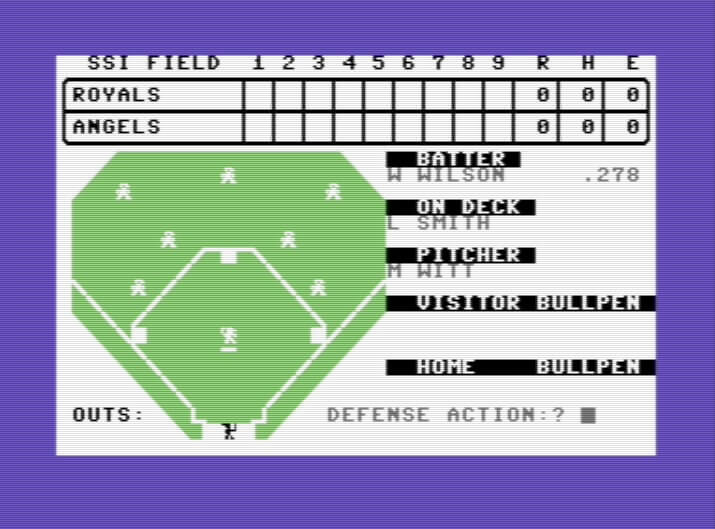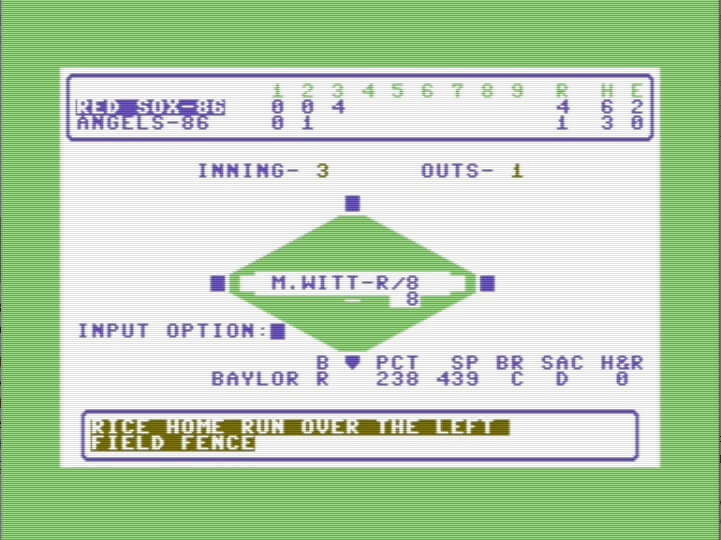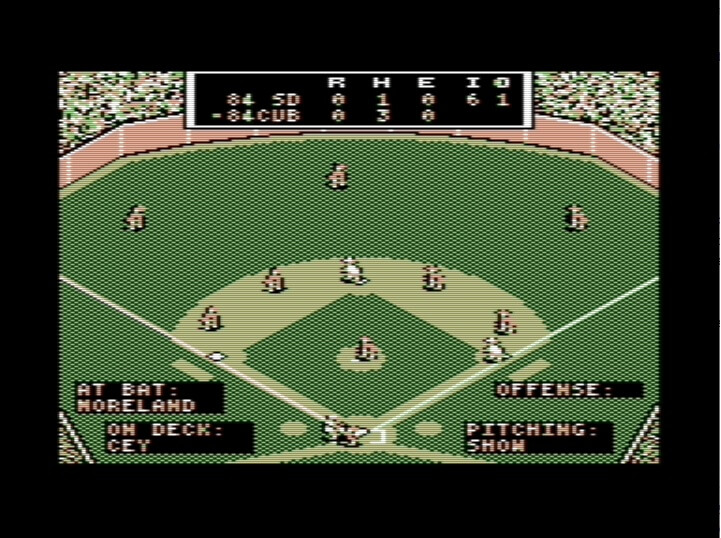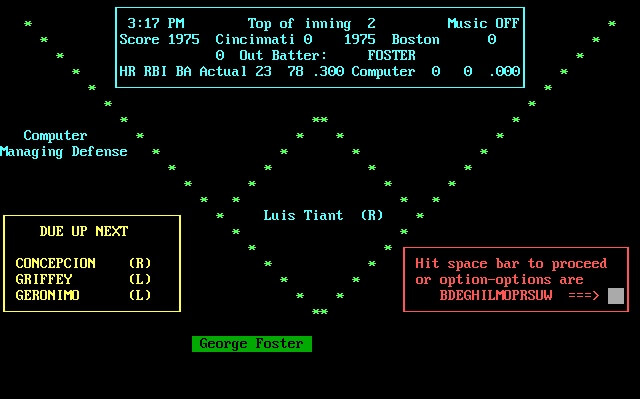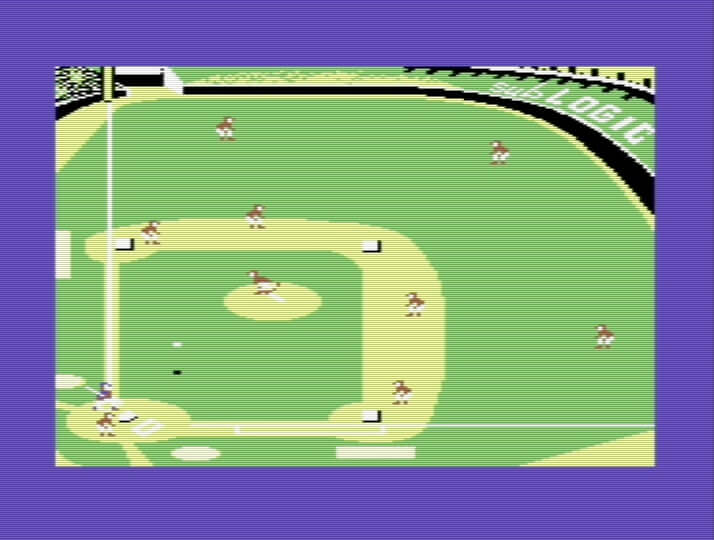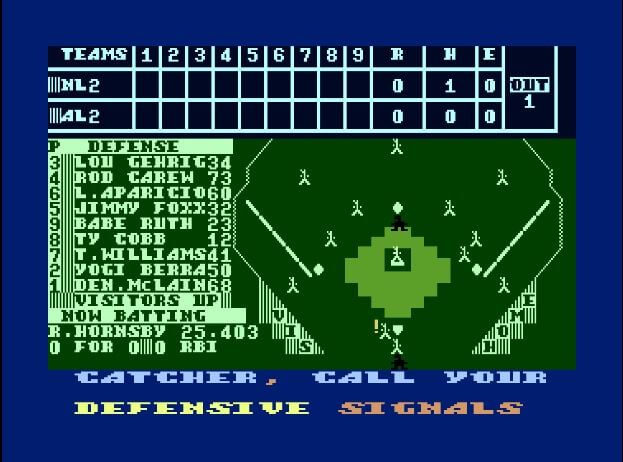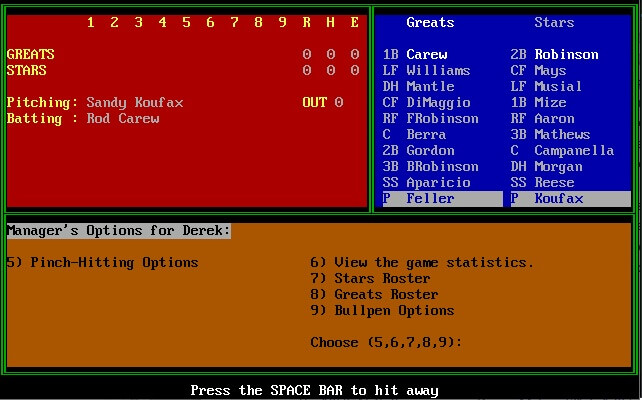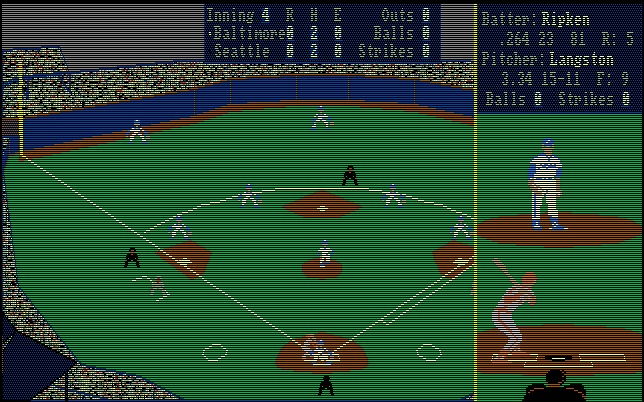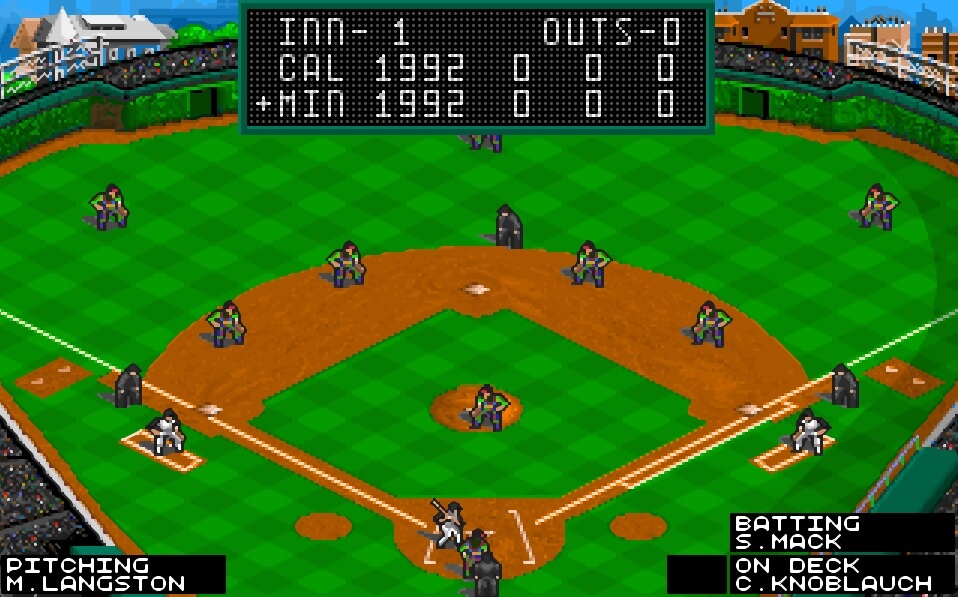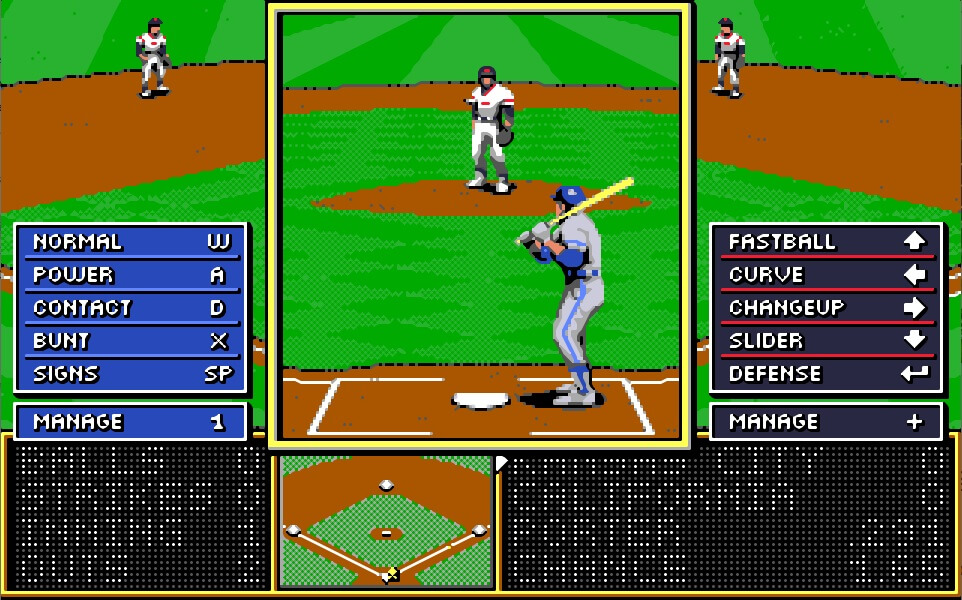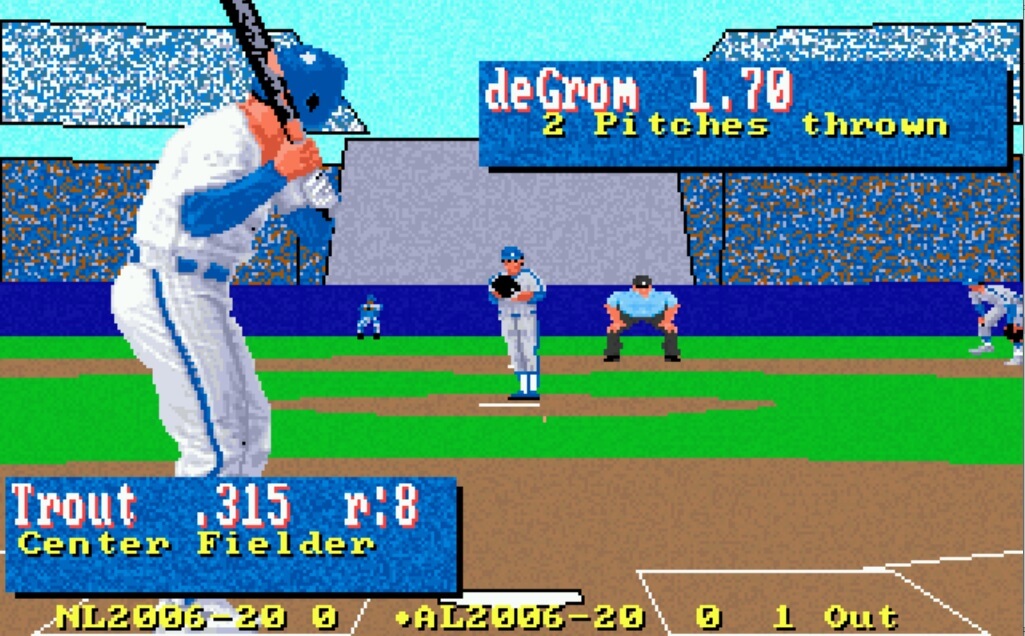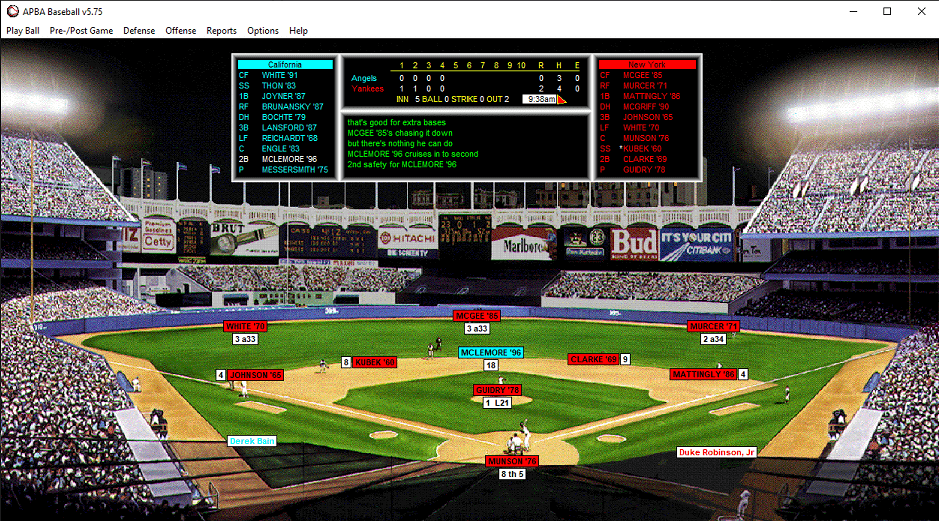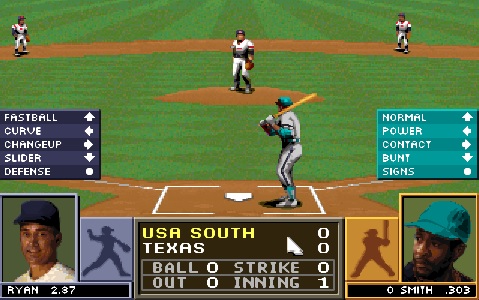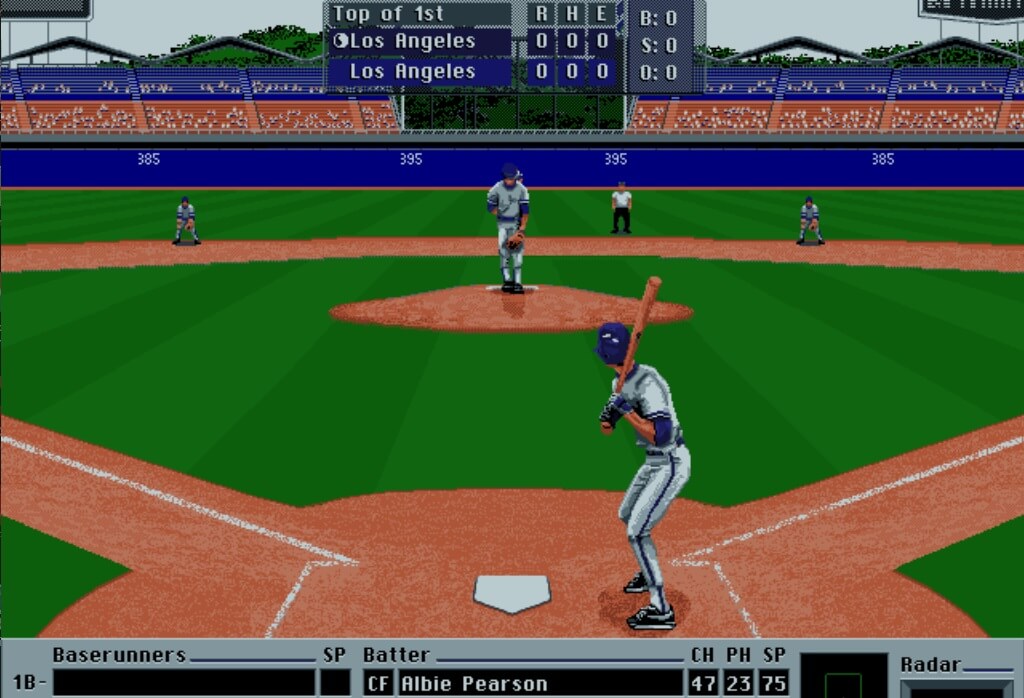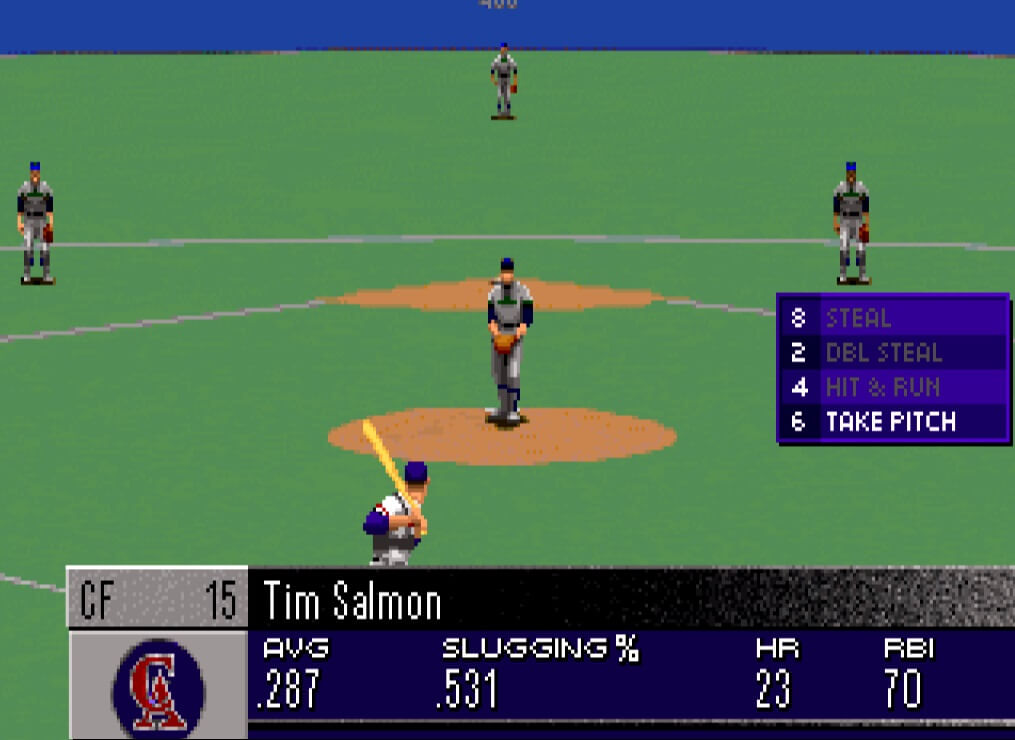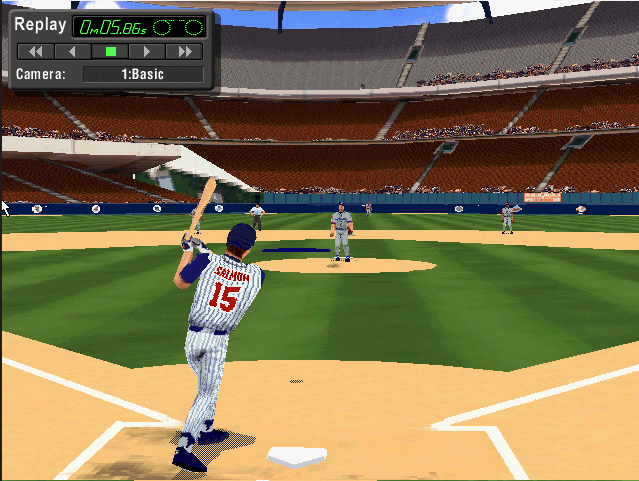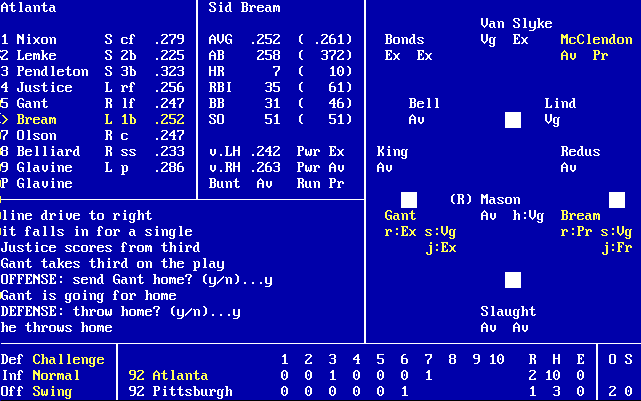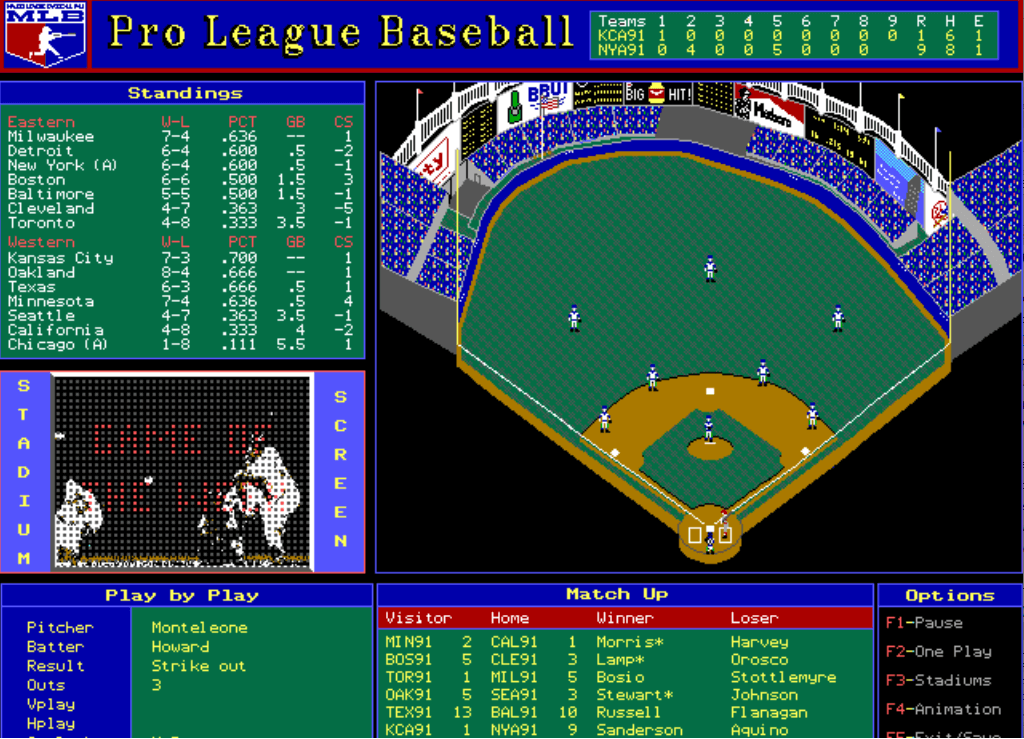This is the ninth entry in a series focusing on computer baseball simulations to supplement the chapter “Play Retro Baseball Video Games In Your Browser” from my Hardball Retroactive book along with the corresponding post at Hardball Retro. The series focuses on baseball simulations – games in which the primary emphasis is on managerial strategy and the ability to replay entire seasons with a degree of realism. Baseball video games that are strictly arcade representations of baseball (based solely on reflex and hand-eye coordination) are excluded.
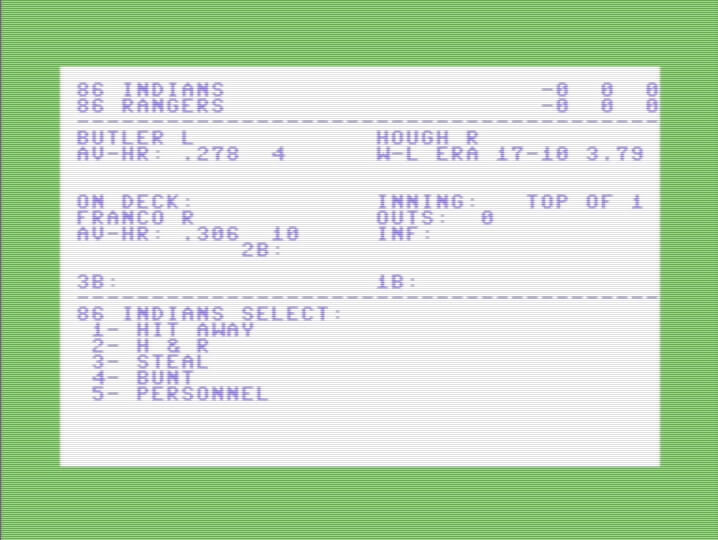
Full Count Baseball
Publisher – Lance Haffner Games
Release Year – 1987
Platforms –Apple ][, Commodore 64, IBM PC
Credits
| Game Design & Programming: | Lance Haffner |
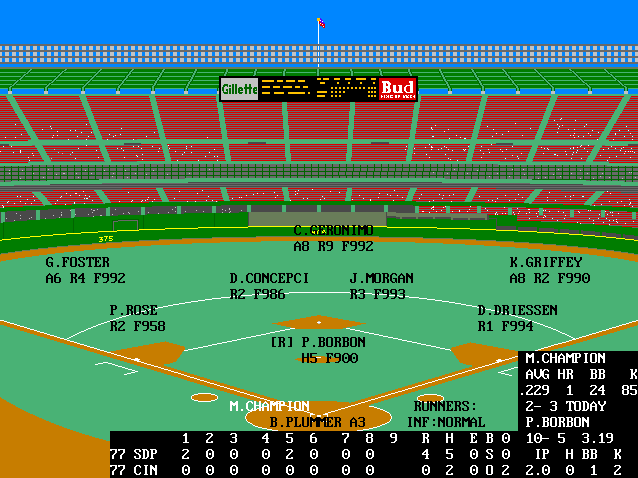
Full Count Baseball 6.0
Publisher – Lance Haffner Games
Release Year – 1994
Platforms – IBM PC
Credits
| Game Design & Programming: | Lance Haffner |
| Ballpark Graphics Implementation & Commentary: | Shannon Lynn |
Programmer Interview
Lance Haffner founded his company, Lance Haffner Games, in 1984. LH Games published multiple text-based sports titles including 3-in-1 Football, Basketball: The Pro Game, Break Point Tennis, Courtside College Basketball, Hat Trick Hockey, Rampage Wrestling, TKO Pro Boxing, TMG Indianapolis Racing Game, TMG Stock Car Racing and World Class Track and Field.
I contacted Lance and he responded to a series of questions about Full Count Baseball.
DB: How did you conceive the original design of Full Count Baseball? Did you have any prior game development or programming experience?
LH: I already had created 3-in-1 Football and Final Four College Basketball. The skeleton was already there. I modified the Select Lineup from the CBB game and then modified Select QB from 3-in-1 FB. I then had to flowchart Full Count as a 9 inning game. I used a lot of code from the Football and CBB games for stat keeping and stat accumulation. Keeping track of earned runs was most difficult. I had to create a separate base running template which moved runners and kept score replacing errors with outs, etc. I had a friend, Randy Dudley, visit me for a weekend and together we designed the computer manager. He was way more knowledgeable about the MLB game than I was at the time.
DB: Did you take any computer programming courses in high school or college?
LH: In high school there was no such thing as computers in the 60s. I didn’t even have hand calculators. I made up sports games to play using 2 or 3 dice. They were simple but fun and fast to play. In college, my freshman year, they had a course called ‘Intro to Algorithms’. It was a senior level course using Fortran. My advisor gave me permission to sign up for the class since it was a Mathematics elective. I believe there were only 6 people in it. I spent an entire weekend going over the book and wrote all the programs we had to write in one weekend using a legal pad. Programming came naturally to me because it was problem solving. I loved that and it’s the same thing as Math which was my major.
Spring or fall of 1969 I wrote a simple baseball game that would replay the World Series between the Mets and Orioles. I did it on an old IBM 1620 which used cards you had to type in on a keypunch machine. I forget how many cards but it was thousands of them. I remember people telling me, “Don’t ever drop those cards!” I didn’t. No one gave the Mets a chance to beat the Orioles. In my replay, the Mets beat them 4 games to 2. Seaver was masterful. I remember Ron Swoboda hit a winning HR in the last game. They ran stories on it in the school paper. It was fun. I guess that was my first experience with computer games.
In 1975 I went to Nashville Tech and majored in Computer Programming. They still used a mainframe with cards but Digital Equipment Corp. had just come out with a mini-computer. I quit school and went to work for a computer software company. In 1978 I left them and hired on at Purity Dairies in Nashville to finish developing a route settlement system for them. That is the time I began developing my games written in a language called DIBOL on a DEC VAX computer at work. It took 5 years to develop the football and basketball games. I went slowly and did it right. I had season tickets to Vanderbilt football and basketball. I attended football games with a clipboard and charted how long each type of play took. Fans around me thought I was a scout from UT but that research made the time of the game as realistic as you could get.
DB: I have the original (Commodore 64) version along with Full Count Baseball 6.0 for the IBM PC. I believe Version 1 was also available for IBM PC and Apple 2. Were any of the later versions available for systems besides IBM PC (such as Amiga, Atari ST, Macintosh?)
LH: My first games were for the Apple 2 computer. One of the dairy owners’ sons was an avid gamer. I did football and basketball on the computer at work then recoded them in Apple BASIC. it was convenient because a bunch of kids from the local high schools and colleges would come over to the dairy at night and on weekends and play them. I think we had 16 computers. They were all occupied with students playing 3-in-1 Football and Final Four (later Courtside) Basketball. They were my play testers; whenever the game would crash they would tell me and I would fix it. After a short while the games were error-proof.
I didn’t do the baseball game like that. By the time I started on Full Count, I had enough code to copy, paste and modify. The baseball went pretty quick. I think I came out with it in ’85 or ’86. I sold more Commodore 64 than anything and Apple 2 was second. The first IBM PC came out in 1982 I believe. I bought a PC Junior. It was expensive and slow. Shortly after that, all the IBM clones started coming out. I never fooled with Mac as the market was very small at the time, mostly used for graphic design. I paid a guy $1,000 to make the football game for Atari. By the time he finished it, Atari was dead. My IBM game worked for the Amiga but the computer never took off and died. Commodore 64 was far and away biggest market but they came out with the Commodore 128. Nobody bought them and the few who did just ran Commodore 64 games on them. Sometime after that, Commodore folded. I was sad to see that.
DB: Did you produce a Windows version of FCBB? What was the last version in the series and when was it released?
LH: There is a group who still play my games on Facebook (Lance Haffner Sports Sims) . I think about 1,000 people still play them using a DOS emulator program to run them on Windows machines. I believe a guy is working on a Windows version of the games.
Internet killed my mail order business. People could zip and e-mail my games to each other. Sales were down so much by 1996 that I had to go back to work on a contract basis to make enough to have a decent life for my kids. I owed it to my 3 boys to try to do better for them. By 2006 it was less than 1,000 bucks a month. I shut it down in 2007 so I could spend more time with my kids and went back to work full-time. I went on a bunch of sites that had LH Games rooms – Yahoo and all, about 6 of them. I was hardly selling any new season disks. These sites had thousands of messages saying ‘leave e-mail and we will send you Haffner’s new team disks’. That was the final straw for me.
DB: Describe your role in the development of each product. Were you the sole developer / programmer throughout the entire series of FCBB?
LH: I was the sole developer and generated the team ratings. A guy in St. Louis did the arm, range and run ratings for me. He has passed away. A guy in Missouri did the graphics and Shannon Lynn made them work within the game. The older field displays were created in an older paint program. I was going to use photos of the ballparks from behind home plate but found out they were licensed and they wanted a fortune to use them. Lynn added some commentary to the games. Players played my games for accuracy and speed. They didn’t care about the commentary. Most of them could visualize a Mickey Mantle home run from memory and didn’t need graphics or commentary.
DB: Did anyone else contribute to utilities, season disks, play testing?
LH: I paid a couple of guys to create the past season disks for me. I can’t even remember their names now. Phil Lupi and friends (in the Facebook group) have done all the seasons for all the games since 2006 when I quit. Phil is even working on College Basketball seasons from the 50’s (’59 and ’54 I think). They also did the 4 seasons I never got around to doing (1973, 1974, 1978 and 1979 I believe). They’ve done a lot of good stuff.
DB: Full Count Baseball focused on the gameplay and the engine. Some of your competitors migrated their DOS products to Windows in the early to mid-1990’s and added stadium graphics, sound effects, broadcasters to provide the play-to-play commentary, etc. Did you consider migrating the products to Windows during that timeframe? Did you consider adding any “eye” and “ear candy” to the product? Your competition in that era included APBA, Diamond Mind and Strat-o-Matic for text-based sims along with the Earl Weaver and Tony La Russa Baseball, games which delivered both arcade and simulation options. What were your impressions of those products at the time and in what areas do you feel that the FCBB series excelled in comparison?
LH: I never saw any of those games. I didn’t want to even see what they were doing. They were based on dice rolls. I used actual percentages. There was also Big League Manager by Negameco in Minnesota. I used ballpark ratings which affected home runs. I think I had a foul ball rating affecting foul ball outs behind home plate. I considered myself a creator and developer, not a follower. My motto was always if you start copying someone else, you will always be at least in second place.
As far as graphics were concerned, I never cared for them. Most of my customers didn’t either. My theory was if you want graphics, turn on a real baseball game and watch it. I had a full plate. I didn’t have time or resources to devote to something that would only slow the game down. My game users wanted accuracy & speed. I gave them what they wanted.
DB: Are you currently working in the computer / gaming industry? Do you have any interest in reviving your game on a current platform?
LH: From 2006 to January 2011 I worked at two manufacturing companies. I was fixing to get laid off in 2011 due to the 2007-08 Great Recession caused by Wall Street gamblers. They offered me one year’s severance. So I took it, paid my bills for a year ahead and retired. I substituted part-time for about two years to supplement my income. Kids’ behavior was so bad I finally quit. You couldn’t pay me enough to sub-teach now. I haven’t done anything on the games since about 2006.
Review
Full Count Baseball (version 1.0)
Full Count Baseball is a text-only computer baseball simulation similar in concept and execution to SSI Computer Baseball and Computer Statis Pro Baseball. FCBB compares favorably to those efforts; however by the mid-1980’s, microcomputer hardball fanatics had their expectations raised by graphical simulations such as MicroLeague and Earl Weaver Baseball. The first version of FCBB was released for IBM PC, Apple ][ and Commodore 64. I am utilizing the Commodore 64 edition and the VICE emulator to play a series using the 1986 Team Disk. Upon loading the game, I chose option 1 (“Play a Game”) from the main menu. I was prompted to place the Team Disk in the drive, then entered the display speed (1-100), number of players (1 or 2 humans, or computer vs. computer) and whether to use the designated hitter. To select the visitor and home teams, you need to know the corresponding number of each team. I had to check the disk directory to determine that Cleveland was team # 12 and Texas was team # 19. When choosing your starting lineup or today’s pitcher, you are allowed to bench anyone that may be unavailable due to fatigue. The contest begins after placing the Game Disk back in the drive (does anyone miss swapping floppies?!)
I scheduled a Series between 2 upstart teams from the 1986 campaign – Cleveland and Texas. Knuckleballers Tom Candiotti (16-12, 3.57) and Charlie Hough (17-10, 3.79) squared off in the initial tilt. Pete Incaviglia drove in the first run of the contest with a deep drive to center field over Brett Butler’s head as Oddibe McDowell scored with ease from second base. Steve Buechele deposited a three-run shot into the left field bleachers in the bottom of the second, increasing the Rangers’ advantage to 4-0. Candiotti issued a walk to Darrell Porter, loading the bases for Buechele. I signaled to the bullpen for Rich Yett, who escaped the jam with a groundout to second-sacker Tony Bernazard. In the top of the fourth, Pat Tabler sent an opposite-field tracer to the warning track in right but “Inky” flagged it down. Yett yielded a solo shot to Incaviglia in the home half of the fifth. Successive safeties by Larry Parrish and Darrell Porter sent Yett to the showers in favor of fellow right-hander Dickie Noles. Buechele popped up to Brook Jacoby at third base to end the fifth. Joe Carter legged out a three-base hit with two away in the visitor’s sixth, only the third hit allowed by Hough. The wily veteran stranded Carter when he dazzled Andre Thornton with a flutterball. Incaviglia just missed a 3-run blast in the bottom of the sixth as Butler made a spectacular leaping grab at the wall! John Butcher entered the contest and limited Texas to a base hit by Porter. The Tribe finally got on the board with 2 outs in the eighth. Butler’s patience was rewarded with a base on balls. Julio Franco drilled a two-base knock to left-center, scoring Butler all the way from first base. Joe Carter tapped a slow roller towards first and Pete O’Brien stepped on the bag to retire the side. Curtis Wilkerson led off the bottom of the eighth with a single, stole second and scored on a double down the right field line by McDowell. Bryan Oelkers relieved Butcher, but Scott Fletcher blistered a two-bagger to left as Texas assumed a 7-1 lead. O’Brien put the game out of reach, mashing a two-run tater into the right field seats. The Rangers prolonged their offensive barrage as Gary Ward ripped a single to left, swiped second and came home on a two-run dinger by Parrish. When the dust settled, Hough returned to the mound with the top of the ninth with a 10-run cushion. Mel Hall lined a single to right and Tabler roped a double to left-center, but Hough induced a shallow fly ball to center off Bernazard’s bat. McDowell corralled it for the final out as the hometown Rangers claimed bragging rights with an 11-1 blowout.
Veteran right-hander Phil Niekro (11-11, 4.32) took the hill in the second contest against 20-year-old rookie Ed Correa (12-14, 4.23). Joe Carter reached base with two outs when Steve Buechele booted his grounder to third. Cleveland capitalized immediately as Andre Thornton tagged a long double off the left field wall, scoring Carter all the way from first. Oddibe McDowell sparked the Texas offense with a ringing two-base hit in the bottom of the inning. Scott Fletcher laced a single up the middle to plate McDowell. Pete Incaviglia clubbed a tape-measure shot off “Knucksie” to provide the Rangers with the 2-1 lead in the home half of the fourth. Texas extended their advantage to 4-1 when Niekro yielded a two-run dinger to Don Slaught. Cleveland threatened in the sixth when Julio Franco ripped a base hit to left, then advanced to third on a single by Carter. Thornton lofted a soft single to left-center, knocking in Franco. Mel Hall bounced into a 6-4-3 double play as Correa escaped further damage. The Tribe rallied again in the seventh as Pat Tabler and Brook Jacoby delivered back-to-back singles. Tabler raced home and Jacoby jogged down to second on a wild pitch by Correa. Brett Butler popped up to third and Franco whiffed, preserving a 1-run cushion for the Rangers. Scott Bailes relieved Niekro after Fletcher walked leading off the bottom of the eighth. Facing the heart of the Texas’ order, the southpaw retired the side. Tabler rapped a base hit to start the top of the ninth, sending Correa to the showers in favor of Greg A. Harris. Jacoby grounded into a fielder’s choice, erasing the lead runner (Tabler). Tony Bernazard belted the next offering off the top of the right field fence for a two-base knock as Jacoby chugged around the bases to tally the tying run! Carmelo Castillo, batting for Chris Bando, swatted a deep fly ball to center but McDowell hauled it in at the warning track for the second out. Butler hit a two-hopper to Curtis Wilkerson to complete the inning. Ernie Camacho entered the contest for the Indians. Larry Parrish lofted a soft single to left. Slaught slugged a long fly to center that was flagged down by Butler. A base hit off the bat of Buechele placed the winning run on second base with one away. McDowell tripled into the right-center field gap and the Rangers celebrated another victory.
The series transferred to Cleveland as the Tribe endeavored to recover from a 2-0 deficit. Jose Guzman (9-15, 4.54) finished his pre-game tosses in the bullpen while Ken Schrom (14-7, 4.54) jogged to the Municipal Stadium mound. The Indians jumped out to a quick lead when Tony Bernazard blasted a 2-run bomb into the right field stands after Brett Butler reached on an error by third baseman Tom Paciorek. Joe Carter laced a single to center but he was erased with a strong throw by Don Slaught on a stolen base attempt. On the next pitch Cory Snyder jacked a solo shot to left. Guzman whiffed Brook Jacoby but Texas trailed 3-0. The Rangers returned fire in the top of the second as Gary Ward and Larry Parrish rocketed back-to-back doubles into left-center field. In the third inning, Toby Harrah singled to right and Scott Fletcher roped a two-bagger to place runners in scoring position with one out. Schrom struck out Pete O’Brien, then skipped a curveball under Andy Allanson’s glove for a wild pitch to bring Harrah home. Carter delivered a majestic home run to straightaway center field, extending the Indians’ advantage to 4-2. In the home half of the fifth, Carter repeated the feat with a 2-run moon-shot down the left field line. Rich Yett entered the contest after Schrom loaded the bases with one out in the sixth. Slaught grounded into a fielder’s choice to cut the Cleveland lead to 6-3, but Yett managed to strike out Paciorek to retire the side. Jacoby started the bottom of the sixth with a base hit up the middle, knocking Guzman from the game. Mitch “Wild Thing” Williams, making his first appearance in the Series, yielded a single to Carmelo Castillo, a double to Pat Tabler and an RBI-single to Butler. Bobby Valentine blew a gasket as he chewed out Williams before ultimately signaled for the right-hander, Jeff Russell. Bernazard beat the relay throw on a fielder’s choice grounder as the Indians notched another tally. Julio Franco flailed at a hard slider from Russell to mercifully bring the frame to a close. Yett supplied 3.2 scoreless innings to complete the 9-3 victory for the Indians.
The opposing managers trotted out a pair of portsiders for Game 4 as Mike Mason (7-3, 4.33) prepared to do battle against Neal Heaton (3-6, 4.24). A pitcher’s duel ensued as both hurlers put up goose eggs through the first 4 frames. Heaton walked the bases loaded in the fifth but extracted himself with a ground out to second base. In the home half of the inning, Brett Butler hit a tracer into the left field corner for a 2-run triple. Joe Carter led off the bottom of the sixth with a double to left-center and later scored on a base hit off the bat of Pat Tabler, knocking Mason from the contest. Brook Jacoby greeted reliever Jeff Russell with a single back through the box and Cory Snyder came around to give the Tribe at 4-0 lead. Mitch Williams entered the match with 2 outs in the seventh after Russell yielded a single to Julio Franco and a base on balls to Andre Thornton. Snyder promptly delivered a single to right. Ruben Sierra fired a rocket towards home plate but Franco slid under Don Slaught’s tag as the Indians padded their lead. Tabler followed with another safety to drive in “Thunder” Thornton. Jacoby narrowly missed a four-bagger as Oddibe McDowell drifted back and made the catch on the warning track. The Rangers threatened in the top of the eighth. Larry Parrish blasted a deep fly ball with 2 outs and runners on second and third, but Cory Snyder sprinted towards the fence and made a leaping grab to preserve the shutout. Heaton retired Texas quietly in the ninth to notch the victory and even the series at two games apiece.
Charlie Hough and Tom “Cotton” Candiotti would keep their catchers busy in the rematch of the dueling knucklers. Texas drew first blood in the third inning when Curtis Wilkerson walked, swiped second and came around on a single to center by Oddibe McDowell. Candiotti proceeded to get into a bases loaded jam but extricated himself with a strikeout of Pete Incaviglia. Gary Ward launched a moon-shot leading off the top of the fourth, putting the Rangers ahead 2-0. Larry Parrish followed with a long double to left-center and he later scored on a pair of wild pitches during Steve Buechele’s at-bat. Candiotti dug a deeper hole when Buechele ripped a base hit, stole second and registered the Rangers’ fourth tally on a triple by Wilkerson. Scott Bailes entered the contest to face the top of the order with one out in the fourth and Cleveland behind by 4 runs. McDowell lifted a medium fly to center, deep enough to score Wilkerson. The Tribe scratched across their first run on an RBI single by Tony Bernazard. Rich Yett relieved Bailes with 2 outs in the fifth and the sacks full of Strangers. The right-hander issued a walk to Buechele to force in “Inky”. Wilkerson followed with a 2-run single to right. McDowell belted a long fly to center which Butler tracked down at the wall as Texas comfortably led the contest, 8-1. In the home half of the fifth, a sacrifice fly to left by Andre Thornton inched the Indians a bit closer. Hough cruised into the eighth inning when Jeff Russell replaced him on the mound. Russell got the final four outs as the Rangers returned home up three games to two in the Series.
Back at Arlington Stadium, Texas elected to pitch Ed Correa while Cleveland countered with the wily veteran Phil Niekro. In the top of the first, Julio Franco roped a two-out two-bagger to center and took third on a poor relay throw by Oodibe McDowell. Correa showed his composure in the big moment by inducing Joe Carter to tap a weak grounder to Pete O’Brien. Andy Allanson led off the third with a ringing single to left which Pete Incaviglia misplayed, allowing the Indians’ backstop to advance safely to second. Again, Correa weaved through the top of the Tribe order to escape the inning unscathed. Ruben Sierra put the Rangers on the board with a two-out triple in the home half of the fourth, scoring third baseman Larry Parrish. Don Slaught followed with a base knock to left and Texas took a 2-0 lead. In the fifth, O’Brien lofted a sacrifice fly to right and McDowell barely evaded the tag at home plate following a strong throw by Cory Snyder. Slaught belted a solo shot into the left field bleachers, extending the Rangers advantage to 4-0 in the sixth. Bryan Oelkers relieved Niekro and yielded a round-tripper off the bat of Toby Harrah. Correa continued to confound the Cleveland offense, putting up zeroes through seven frames. Ernie Camacho entered the contest after Oeklers issued a walk to O’Brien leading off the bottom of the seventh. The right-hander whiffed “Inky” and Sierra but got burned on an inside fastball that Slaught mashed for a two-base hit. Correa remained on the mound with a 6-run lead into the ninth inning. Brett Butler coaxed a leadoff walk but he was promptly erased when Franco rapped into a 6-4-3 double play. Carter popped up to shortstop Scott Fletcher and the Rangers greeted Correa at the mound to celebrate their victory! The young right-hander merited Series MVP honors as he held the Tribe to 2 earned runs in 17 innings while striking out 16 batsmen.
Full Count Baseball 6.0
I downloaded the season disks and related files from the link provided in the Lance Haffner Sports Sims group on Facebook. Here is the link to the Full Count Baseball files in Google Drive.
I simulated the 1977 season to give Rod Carew another shot at the .400 mark. FCBB v6 allowed me to generate the appropriate schedules for the American and National League. I replayed the season one month at a time. On the first of each (simulated) month, I stopped to review the results.
The Twins hosted the Red Sox for their final regular season series. A 2-for-4 effort in Game 160 against Reggie Cleveland and Bill Campbell raised Carew’s BA to .400 with a pair of games remaining on the schedule. One day later he delivered 3 safeties in 4 at-bats against four Red Sox hurlers to raise his average to .402. In Game 162, Bill F. Lee, Bob Stanley and Campbell held Carew hitless in five at-bats dropping his batting average to .399! The Twins’ first baseman also led the League in base hits (248), runs (141), doubles (53) and OBP (.461) while placing runner-up with 16 triples. Rick “Rooster” Burleson (.371), Bob Bailor (.365) and Mickey Rivers (.352) delivered career-highs in batting average. Angels’ outfielder Bobby Bonds easily outdistanced Jim Rice for the home run crown, 48 to 36. Yankees’ relief ace Sparky Lyle collected the ERA title with a mark of 2.23. Garry Templeton secured the N.L. batting title by five percentage points over Ken Griffey, .341 to .336. George Foster bested Bobby Murcer in home runs by a lone dinger, 44 to 43 and teammate Tom Seaver paced the circuit with a 1.72 ERA.
The Yankees and Royals tallied 103 victories apiece to lead their respective divisions by double-digits while the Phillies handily claimed the National League East by 9 games over the Pirates. The Reds claimed the remaining playoff berth by a single game over the division-rival Astros.
Kansas City knocked off New York in five games and Cincinnati prevailed over Philadelphia in four contests to advance to the World Series. I elected to manage the Royals.
ALCS
5 – KCR 9 @ NYY 3
KCR wins ALCS 3 games to 2
NLCS
3 – CIN 0 @ PHI 4 (Bench broke up Lonborg no-no with 2 outs in 7th)
4 – CIN 4 @ PHN 3 (10 innings)
CIN wins NLCS 3 games to 1
Kansas City opened the scoring in the bottom of the first when Amos Otis scorched a single to left off Tom Seaver to drive in Hal McRae. Cincinnati knotted the game at 1-1 as Dennis Leonard served up a gopher ball to Johnny Bench in the top of the second. Cesar Geronimo delivered a two-out hit later in the inning to plate Dan Driessen with the go-ahead run. John Mayberry and Al Cowens produced successive singles as the Royals regained the lead, 3-2 in the bottom of the third. Frank White chipped in with a two-out RBI single to tack on the fourth tally for KC. Sparky Anderson aka “Captain Hook” went to the bullpen early as he yanked “Tom Terrific” in favor of Mike Caldwell after McRae slammed a two-base hit off the left field wall leading off the bottom of the fourth. Otis subsequently singled to left and McRae scampered home with the Royals’ fifth run. Manny Sarmiento became the third Reds’ pitcher after Champ Summers batted for Caldwell. He twirled a couple of scoreless frames before giving way to Pedro Borbon to start the home half of the seventh. Consecutive knocks by Mayberry and Cowens placed runners on the corners with nobody out. Darrell Porter singled through the drawn-in infield as Kansas City expanded the lead to 6-2. Throwing errors by Joe L. Morgan and Driessen on successive plays yielded another run for the hometown team. George Brett’s bloop single with the sacks juiced plated two more baserunners. McRae greeted Dale Murray with a two-bagger off the left-field fence. When the dust finally settled, Andy Hassler replaced Leonard on the mound with a comfortable 10-2 cushion. Cincinnati immediately pounced, loading the bases on a double by Morgan, a base on balls to George Foster and a single by Bench. The portsider regrouped and escaped the inning unscathed. Anderson lifted Murray for Rawly Eastwick after Freddie Patek lined an RBI single to center in the bottom of the eighth. Pete LaCock laced a two-out hit to drive in Patek with the twelfth run of the night for the Royals. Hassler allowed an infield hit to Ken Griffey and walked a pair of Reds with two outs in the ninth. Mark Littell trotted in from the bullpen and promptly whiffed Bench to secure the 12-2 win.
Pete Rose coaxed a leadoff walk off Jim Colborn in Game 2. “Charlie Hustle” swiped second and later scored on a sacrifice fly off the bat of Joe L. Morgan. John Mayberry tied the game with a solo shot off southpaw Fred Norman in the bottom of the second. Ken Griffey ripped a double to commence the top of the fourth and he tallied the go-ahead run for the Reds on a two-out, two-base hit by Johnny Bench. Al Cowens delivered a base knock and Norman issued a pair of walks to place ducks on the pond with nobody out in the home half of the fourth. John “Duke” Wathan cleared the bases with a three-bagger as the Royals claimed a 4-2 advantage. Colborn got into a bases-loaded jam in the visitor’s sixth. He got Bench on a shallow fly ball to left but Dan Driessen legged out an infield hit, cutting Kansas City’s lead to 4-3. Dave Concepcion nubbed a slow roller to third and he was called out on a bang-bang play at first to end the threat. Sparky Anderson called upon Manny Sarmiento after Norman walked Wathan with two gone in the sixth. When Colborn issued a free pass to pinch-hitter Champ Summers in the seventh, I selected the Personnel option to assess my bullpen possibilities. Cincinnati had the switch-hitting Rose due up, followed by left-handed batters in Griffey and Morgan. I elected to bring Larry Gura into the game and noted a message on the bottom of the screen – “Colborn is tiring!” I also noted that there is no mechanism to warm up a pitcher. The move to Gura worked to perfection as Rose grounded into a double play. Anderson called upon the portsider Mike Caldwell in an attempt to maintain Cincy’s one-run deficit. Gura left the game for a pinch-hitter (Cookie Rojas) so Steve Mingori got the ball in the top of the eighth. He retired both of the lefties he faced then gave way to Mark Littell, who finished the frame with a short fly to left off the bat off Reds’ cleanup hitter George Foster. Bench walked to start the ninth and he was promptly replaced on the bases by Ed Armbrister. Driessen drilled a line drive that was snared by Mayberry. Armbrister strayed too far from first base and Mayberry stepped on the bag for a double play! Cowens gloved Concepcion’s liner to right as the Royals triumphed 4-3. The Series headed to the Queen City with KC up two games to none.
George Brett reached on an error by Joe L. Morgan leading off Game 3. Jack Billingham served up a long double to Al Cowens as Brett raced around the bases to record the first tally of the contest. “Little Joe” swiftly atoned for his error when he rocked a solo blast off Paul Splittorff with two outs in the bottom of the first. George Foster ripped a two-bagger to left and Johnny Bench’s subsequent single put the Reds in front, 2-1. Splittorff issued a base on balls to Dave Concepcion and then Dan Driessen capitalized with a towering big-fly that barely evaded Cowens’ leaping attempt in the wall for a three-run circuit clout. Cesar Geronimo followed with a single to right but KC finally nailed down the third out of the inning as Billingham whiffed. Splittorff settled down and matched Billingham with five scoreless frames. In the top of the fifth, Ken Griffey made a circus catch of Hal McRae’s opposite-field shot to the right field wall. Two batters later, Geronimo robbed John Mayberry at the center field fence with two outs and two runners on base as Cincinnati maintained a 5-1 advantage. McRae drilled a two-out double in the seventh and Cowens plated him with a base hit to center. Doug Bird held the Reds in check during his relief appearance. Billingham remained on the bump in the eighth as the Royals attempted to rally. Darrell Porter lined a single to right and John Wathan came on as a pinch-runner. Frank White laced a two-out single into right-center, sending “Duke” to third. KC announced Tom Poquette as the pinch-hitter. Billingham stared in for the sign, Bench put down a pair of digits and Poquette just got under it for a harmless pop fly to Morgan. Concepcion hammered a two-bagger up the gap in left-center off Royals’ reliever Marty Pattin and advanced to third on Driessen’s ground out. Pattin walked Geronimo intentionally to bring up the pitcher’s spot. Billingham hit into a fielder’s choice as Cincy tacked on an insurance run. Cowens produced a two-out single in the ninth but Foster caught Mayberry’s shallow pop fly to left for the final out as the Reds secured the 6-2 victory. Billingham went the distance, scattering 11 hits but yielding only one earned run.
Cincinnati looked to even the Series at two games apiece as their ace, Tom Seaver, took the hill against Kansas City in Game 4. The Reds seized an early lead when Cesar Geronimo belted a low fastball from Royals’ starter Dennis Leonard deep into the right field seats for a three-run bomb in the bottom of the second. KC got one back in the third inning when Frank White reached on a two-base error by Reds’ shortstop Dave Concepcion. Leonard laid down a beautiful sacrifice bunt to advance White ninety feet and George Brett registered an RBI on a fielder’s choice ground out to short. The Royals drew closer when White singled with one out in the fourth, pilfered second base and scored on base hit grounder through the right side off the bat of Leonard. Ken Griffey drilled a line drive off Leonard’s leg in the home half of the fourth. The manager and trailer came out to assess the situation and Marty Pattin replaced the injured starter on the mound with two runners aboard and nobody out. Joe L. Morgan grounded into a 6-4-3 double play and George Foster bounced out to White as Pattin rallied the troops and escaped without any damage. The Reds tacked on an unearned run when Geronimo lofted a sacrifice fly to center to plate Dan Driessen in the bottom of the sixth. Mark Littell became the third KC pitcher after Tom Poquette batted for Pattin in the seventh. He promptly loaded the bases with no outs on a pair of walks sandwiched around a safety by Pete Rose. Larry Gura was summoned to face Morgan. “Little Joe” flew out to the warning track in center field, driving in “Tom Terrific” with Cincy’s fifth tally. Foster’s subsequently tapped a slow roller to shortstop for a fielder’s choice and Rose raced home to give the Reds a comfortable 6-2 lead. In the eighth, Seaver added an insurance run when he clubbed a two-base knock off the left field fence. Geronimo scored all the way from first. “The Franchise” yielded base hits to Darrell Porter and Freddie Patek in the ninth but he got White to hit a high chopper to Driessen for the final out of the contest. The Reds prevailed 7-2 and knotted the Series at 2-2.
Veteran hurlers Fred Norman and Jim Colborn squared off in Game 5. George Brett smacked a triple into the right-field corner leading off the game for the visitors. Al Cowens hit a deep drive to the opposite field with one away. Ken Griffey drifted back to the warning track and timed his leap perfectly to rob Cowens of extra bases. Brett tagged and raced home with the Royals’ first run. Cincinnati registered four straight hits against Colborn in the bottom of the first. Joe L. Morgan belted a two-run triple up the gap in right-center to drive in Pete Rose and Ken Griffey. George Foster followed with a single to left to plate “Little Joe”. Colborn got the quick hook with two outs in the first in favor of portsider Andy Hassler. Cesar Geronimo drew a free pass to load the bases and Norman drove in a pair with a line drive single to right field as the Reds batted around. Frank White snared a shot by Rose to end the frame with Cincy out in front, 5-1. In the top of the second, White responded with a two-run single down the left field line. Larry Gura replaced Hassler on the hill after Cookie Rojas batted for the southpaw in the previous inning. Griffey coaxed a base on balls, advanced to third on a wild pickoff attempt and scored on a single by Morgan. The Reds held a 6-3 advantage heading into the home half of the fourth. Kansas City went to the bullpen again as the manager called upon Marty Pattin to keep his club in the game. Reds’ manager Sparky Anderson lived up to his “Captain Hook” moniker went he summoned Dale Murray with the sacks juiced and two down in the fifth. The Royals’ skipper countered, sending Darrell Porter to the dish in place of John Wathan. Murray won the battle as he froze Porter with a strike on the inside corner to retire the side. Freddie Patek laced a three-bagger between Geronimo and Griffey. White lashed a single to center and KC now trailed 6-4. Brett absolutely demolished Murray’s offering but it was only a solo blast as Pattin had bounced into a double play after twice failing to bunt White over to second base. Pattin redeemed himself with another scoreless frame in the bottom of the sixth. Amos Otis drilled a single to right with one away in the sixth and Anderson signaled for right-hander Pedro Borbon. The visitors tied the contest at 6-6 when John Mayberry and Porter produced back-to-back singles against the Reds’ reliever. After Patek flew out to right, White delivered a two-out opposite field hit and Mayberry scampered home with the go-ahead run. Tom Poquette batted for Pattin and grounded out to Morgan. Mark Littell took the mound for the visitors in the bottom of the seventh with his squad holding a 7-6 lead. He shut down the Big Red Machine in order. Hal McRae slashed a one-out single to right and Anderson went to his bullpen. This time it was Manny Sarmiento who got the call. The right-hander made quick work of Cowens and Otis. Littell worked out of a jam in the eighth, inducing Rose to ground out to second base after Champ Summers rapped into a 4-6-3 double play. Rawly Eastwick became the Reds’ fifth pitcher of the day. Morgan walked with one out and Foster nearly left the yard, rattling the left-center field wall for a game-tying two-bagger! Littell issued an intentional pass to Johnny Bench. Steve Mingori, pitching from the left side, came in to face the lefty-swinging Dan Driessen. Anderson sent Ed Armbrister to run for Foster at second base. Driessen blasted one towards the right field wall. Cowens turned and raced back, made a valiant effort but the ball ricocheted off the wall. Armbrister breezed around the base paths and registered the winning tally as Cincinnati came from behind to sweep the three games at Riverfront Stadium. As the teams headed back to Kansas City, the momentum had shifted in favor of the Reds.
The Royals faced a must-win situation on their home turf in Game 6. Paul Splittorff endured a shaky first inning as the Reds loaded the bases before Dave Concepcion swung and missed at a heater on the outside corner for the third out. Cincinnati plated the first run when Bill Plummer drew a base on balls with one away in the second, advanced to third on Jack Billingham’s single to center, and scored on a Pete Rose groundout. Splittorff got the Royals even with a deep fly into the right field seats in the home half of the third inning. George Brett laced a two-out triple in the fifth frame that evaded Ken Griffey and rattled around in the right-field corner but he was stranded at third as the score remained tied at 1. The Big Red Machine pulled ahead in the top of the seventh when Rose lashed a base hit to right and Griffey followed with another single to the same spot. Al Cowens booted the ball which allowed Rose to scamper home. Cincinnati was six outs away from claiming the Championship. Billingham completed his warm-up tosses and stared in for the signal from Plummer as Brett took a few practice cuts. “Mullet” lined a sharp single to right leading off the inning. Hal McRae served a looping single that dropped in front of Cesar Geronimo as Brett raced to third. Cowens made up for his earlier miscue when he legged out an infield hit and Brett streaked home with the tying run. John Mayberry scolded a hot grounder between first and second. McRae just slid under the tag as the Royals took the lead, 3-2 with Cowens and Mayberry taking the extra base on the throw home. Pedro Borbon relieved Billingham. Amos Otis coaxed a walk to load ‘em up for Darrell Porter. Borbon continued to struggle with his control as Porter drew a free pass to force in a run. Freddie Patek flew out to shallow left for the first out. Frank White lofted a high fly towards Griffey. Mayberry tagged up and barely grazed the dish with his hand. Pinch-hitter Tom Poquette grounded out to shortstop and Kansas City entered the ninth with a 5-2 advantage. Mark Littell replaced Doug Bird on the bump and Sparky Anderson sent Dan Driessen up to bat in the pitcher’s slot. Driessen’s drive sent Cowens back to the warning track in right but the ball stayed in the park. Rose bounced out to Patek but Littell issued consecutive walks to Griffey and Morgan, bringing the dangerous George Foster to the plate representing the tying run. Littell fired one in on Foster’s hands and he lifted a high pop fly towards shortstop. Patek settled under it and made the catch for the final out. The Royals survived with a final score of 5-2 to push the Series to a seventh game.
Pete Rose lined a single to center field leading off Game 7 but Dennis Leonard whiffed two of the next three Cincinnati batsmen to put up a zero in the top of the first. Tom Seaver recorded a scoreless frame for the Big Red Machine after setting the Royals down in order. The Reds loaded the bases with two outs in the third on a couple of walks by Rose and Joe L. Morgan sandwiched around a Ken Griffey base hit. Leonard extracted himself from the jam when he induced a fly out to center field off the bat of the Reds’ cleanup hitter, George Foster. Frank White led off the home half of the third with a single to left. He advanced to second on a sacrifice bunt by Leonard and tallied the first run of the game on a base knock to left by George Brett. Cincinnati addressed their 1-0 deficit in the fourth when Dan Driessen ripped a one-out double to right and picked up an extra base on Al Cowens’ throwing miscue. The first sacker scored on Dave Concepcion’s grounder to short. Hal McRae motored into third base with a triple to commence the bottom of the sixth. John Mayberry drew a base on balls with one away. Amos Otis produced a medium fly ball to left. Foster camped underneath it, snagged the ball and fired home. McRae dashed for the plate, slid head-first and brushed his hand across the dish as Johnny Bench applied the tag… SAFE! Royals took the 2-1 lead and the crowd went berserk! Sparky Anderson tried to generate some offense with two outs and no runners on base in the seventh, sending Champ Summers up to bat instead of Seaver. Summers sent the ball on a high arc towards the right field corner. Cowens climbed the wall, reached up and made the catch! Manny Sarmiento replaced “Tom Terrific” on the hill. White laced a one-out triple up the gap in right-center with one down in the bottom of the seventh. Pete LaCock batted for Leonard and lofted a fly ball to center. Cesar Geronimo’s throw home was off the mark as White registered an insurance run. Larry Gura entered the game in the top of the eighth to face the top of the Reds’ lineup. Rose ripped a single to left and Griffey followed with a two-bagger to center. “Charlie Hustle” scored, cutting KC’s advantage to 3-2 but Griffey was cut down at third by a strong throw from Otis. Steve Mingori relieved Gura and yielded a base hit to center by Morgan. Mark Littell was summoned from the pen and he plunked Foster to place runners on first and second with only one out in the inning. Morgan and Foster perfectly executed a double steal, so the Royals elected to issue a free pass to Bench. Driessen delivered a sac-fly to left, knotting the game at 3-3! Concepcion silenced the hometown crowd with a single up the middle, scoring Foster and pinch-runner Ed Armbrister. The Royals’ fourth hurler of the inning, Andy Hassler, came in to retire Geronimo on a lazy fly to left but the damage was done. The Royals had six outs remaining in their season. Cowens started the frame with a sharp single to left. He made a wide turn at first base but wisely decided not to challenge Foster’s arm. Mayberry clobbered Sarmiento’s next offering deep into the right field seats to tie the contest at 5-5! The fans feverishly applauded as the first baseman jogged around the bases. Pedro Borbon was called upon to quiet the Royals’ bats. Darrell Porter coaxed a one-out walk and Kansas City sent John Wathan into the contest as a pinch-runner. Freddie Patek whiffed on a 3-2 offering and Wathan was pegged at second by the backup backstop, Don Werner. Marty Pattin took over for Hassler to begin the ninth and he set down the Reds with ease. LaCock roped a one-out base hit to left field off Rawly Eastwick and immediately exited the contest in favor of pinch-runner Joe Zdeb. Brett grounded into a 5-4-3 double play to send the game into extra innings. Pattin pitched a scoreless tenth and his skipper elected to send Tom Poquette up to the dish when Anderson brought Dale Murray into the game in the bottom of the frame. The pinch-hitter responded with a base hit into right field, setting the table for the heart of the Royals’ batting order. The crowd went into a frenzy when Cowens belted one deep to right but Griffey scaled the wall and hauled it in for a game-saving grab! Poquette had to scramble back to first. Mayberry nearly bounced into a 3-6-3 twin-killing but he just beat Concepcion’s relay to keep the inning alive. Otis worked a walk and Wathan strolled to the plate with the potential winning run standing out at second base. The play-by-play from the national broadcast – “Murray kicks and fires… line drive past Rose and Concepcion… Mayberry scores! Kansas City defeats Cincinnati, 6-5!!” The World Series MVP was awarded to Mayberry who produced 9 hits in 28 at-bats (.321 BA) along with two round-trippers and 5 runs batted in.
World Series
Ratings
Note – ratings below for Full Count Baseball 6.0 – deduct 1 point for Graphics, Box Score, Strategy, 2 points for Artificial Intelligence, Rosters, Statistics, Usage/Injuries/Ejections, Commentary and 3 points for Ballparks/Park Factors in Full Count Baseball (version 1)
Graphics – [2] The screen in version 1 is divided into 3 sections. The top portion of the display contains a typical scoreboard. The mid-section provides basic information regarding the current batter and pitcher along with the on-deck hitter. Batting data consists of the player’s last name, handedness, batting average and home runs while the pitcher’s stats are limited to last name, throwing hand, won-loss record and earned run average. The inning, number of outs and infield status (infield in, in at corners, or blank for normal infield depth) are listed below the pitcher. Baserunners (if any) are enumerated below the batting and pitching record. The lower third of the screen conveys the strategy menu or the play-by-play text. Stadium images are added in version 6 with commentary superimposed in the upper center of the screen. Offensive and defensive menus are relegated to the lower left corner. The scoreboard runs along the bottom center of the screen while current batter and pitcher information is reported in the lower right corner. Defensive player names and fielding data are anchored around the diamond in the appropriate locations.
Sound – [1] Full Count Baseball does not feature any music or sound effects.
Strategy – [3] Managerial options are a bit limited in the first edition of Full Count Baseball compared to contemporary offerings. On defense, there is no way to hold a runner on base or call for a pitchout. The program does not allow you to warm up a relief pitcher or visit the mound for a conference. Your only option is to substitute the current pitcher with a reliever. The “Hold Runner” function is included in version 6.
Artificial Intelligence – [4] The computer manager will generally pinch-hit and replace the pitcher at appropriate intervals in the game. Version 1 does not utilize left/right split stats, so the manager does not take the platoon advantage into account. One problem that I encountered in both V1 and V6… After pinch-hitting for my catcher with an outfielder, I was not prompted to adjust my defense (player out of position) so I inadvertently retained the outfielder as my catcher in the ninth inning. Version 6 includes the ability to edit and generate schedules. A highly customizable “Programmable Manager” grants the ability to fine-tune each skipper’s tendencies.
Box Score – [4] In version 1, the post-game box score contains 5 screens: the line score, the visitor and home batting results, along with the pitching results for both teams. Wild pitches, passed balls and balks are omitted. The user may print the box score and/or compile statistics. If you choose the Compile option, you are prompted to insert a user-provided disk. You can select the Look At Compiled Stats option from the main menu. This provides an account of the team’s record along with the accumulated batting and pitching statistics (4 total screens) for the currently selected team. The game does not keep track of league standings. However it maintains each team’s won-loss record which appears when reviewing compiled statistics. Version 6 features expanded box scores and includes notes when an individual feat occurs. For example, in my 1977 replay, Mickey Rivers legged out a pair of three-base hits in ALCS Game 2. The first line at the top of the box score highlights this accomplishment – “M.RIVERS HIT MORE THAN 1 TRIPLE(S).”
Rosters – [4] – Version 1 affords the use of a 29-man roster (17 batters and 12 pitchers). You have the option to save lineups and load previously saved lineups. Roster sizes are expanded to 45 in version 6.
Statistics – [4] – In the original edition of Full Count Baseball, you can choose to create a new team, draft a team or edit an existing team. The program tracks the standard statistics – no more, no less. Version 6 offers the ability to trade players (batters for batters, pitchers for pitchers) and tracks advanced statistics as well as standard statistics.
Usage/Injuries/Ejections – [4] – I did not encounter any injuries or ejections during the 6 games that I played. You are prompted to select any players that are unavailable prior to entering lineups and choosing the starting pitchers for the current match. I also noticed a ‘-T-‘ next to several of my relievers during the fifth game. I don’t have a copy of the manual but assume that indicated that they were (T)ired. Version 6 allows the user to toggle injuries and pitcher fatigue on/off for a game or entire season.
Ballparks / Park Factors – [4] – Version 1 does not appear to account for any park factors and you do not have the ability to select different ballparks. Version 6 allows you to specify the ballpark after selecting lineups and starting pitchers. Park and weather effects are incorporated into V6.
Commentary – [3] – The commentary appears on the bottom third of the screen, replacing the strategy menus when the ball is in play. There is a brief delay between sentences. The descriptions and variety are minimal. “Franco hits a deep fly ball to CF… Double… Throwing error by O. McDowell.” In version 6, the play-by-play appears in the middle of the screen. A nice touch is the ability to enter umpire names. This feature is only utilized in the commentary and box scores (you can’t enter umpire tendencies, for instance.)
Scale: Ratings from 1 (worst) to 5 (best)
Full Count Baseball (version 1) – Total Score: 17 out of 50
Full Count Baseball 6.0 – Total Score: 33 out of 50
Observations
Full Count Baseball evokes memories of SSI Computer Baseball and Computer Statis Pro Baseball and offers a straight-forward rendition of our National Pastime – enjoyable but lacking in some of the bells and whistles offered by competitors during that timeframe. Later editions built upon the original’s foundation with the features necessary to cement FCBB’s standing in the text-only simulation market. I haven’t had any success locating versions 2 through 5 so please reply in the comments if you’ve played those iterations of the game.
Be sure to check out Jason Leonard’s website, LHGAMES.net, where he offers Full Count Baseball v6 for current Windows, Macintosh and Linux operation systems!
Please add a comment below if you spent a significant amount of time and/or have any recollections of Full Count Baseball.
Screenshots
Full Count Baseball (version 1)
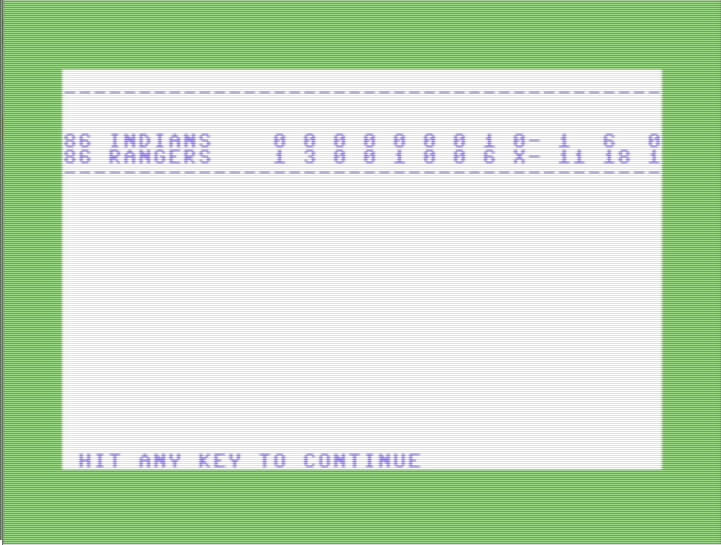
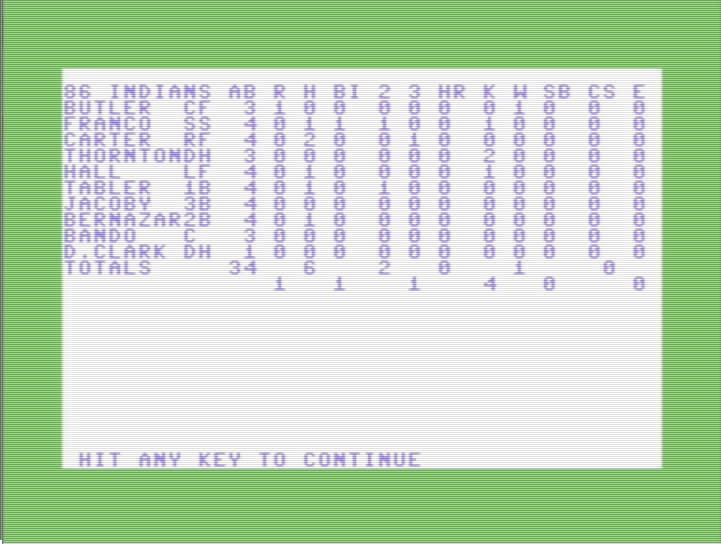
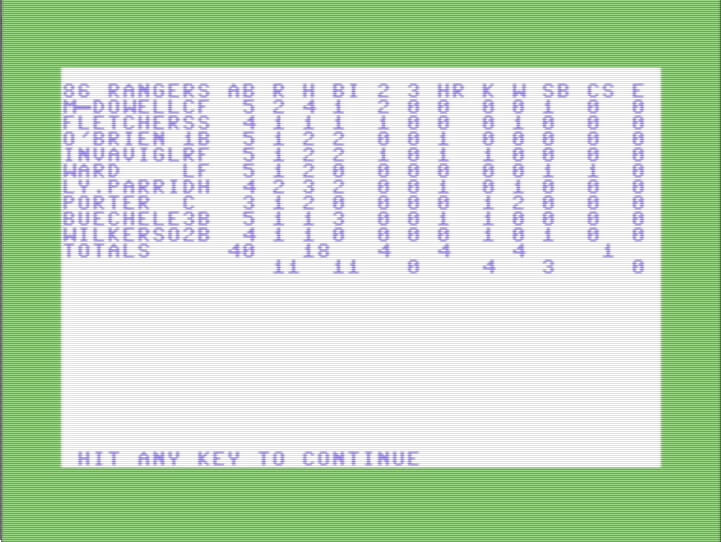
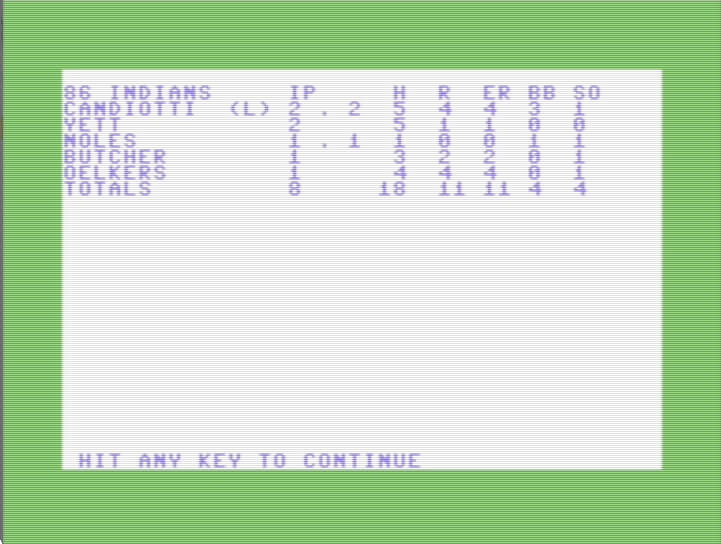
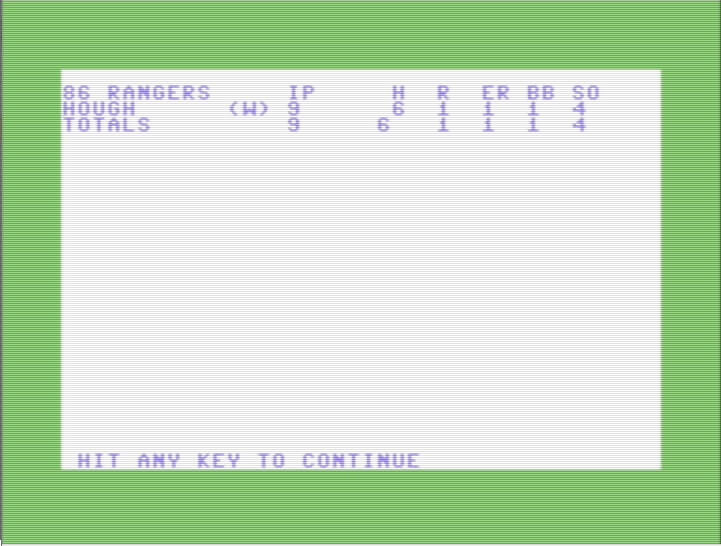
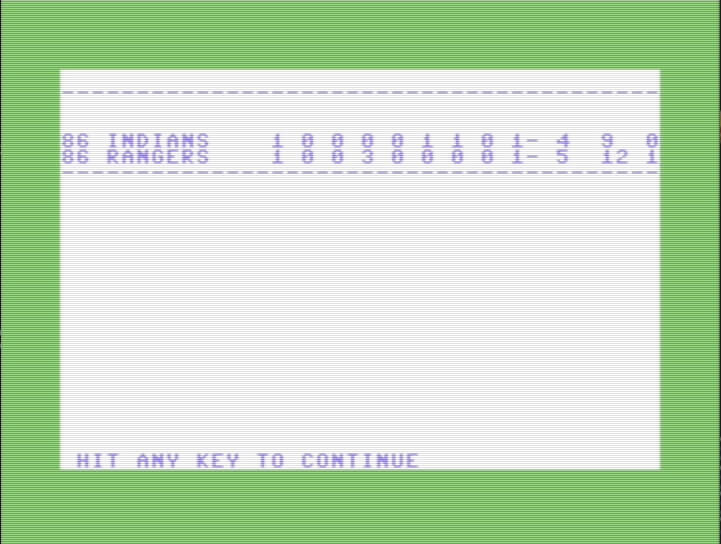
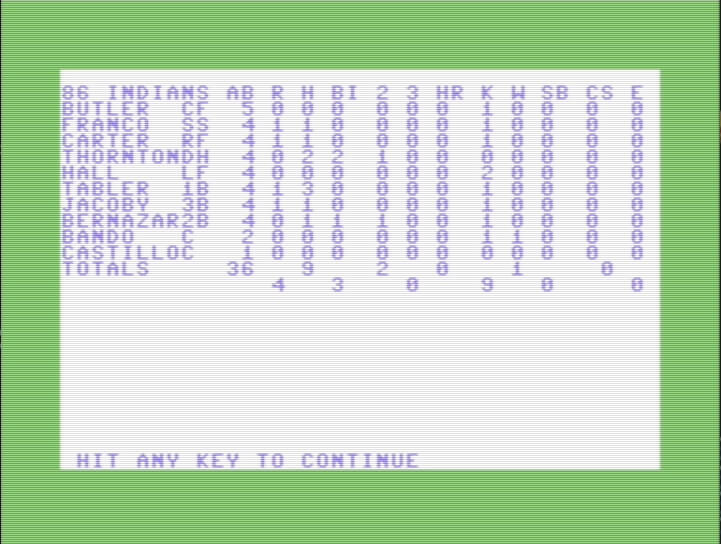

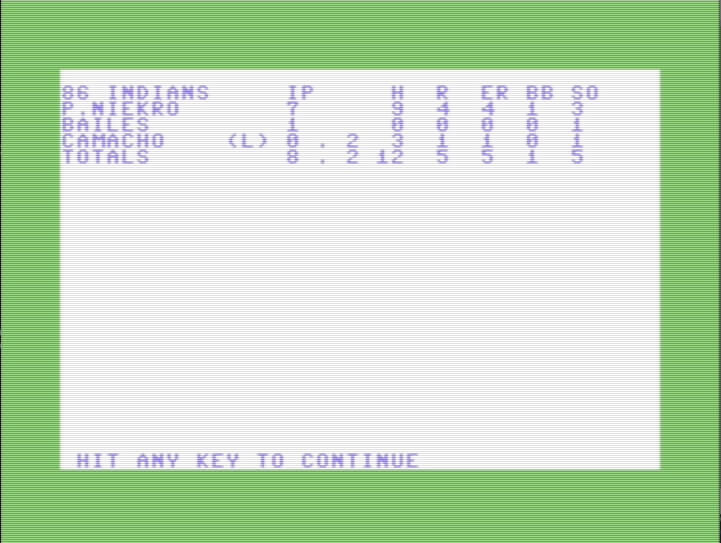
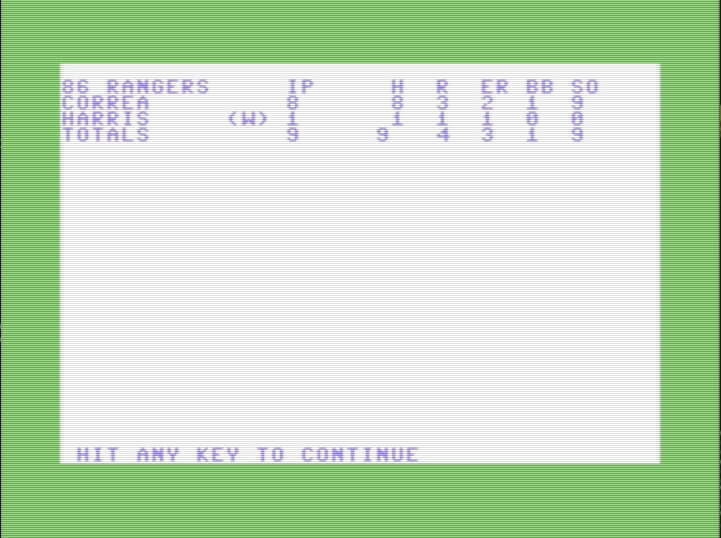
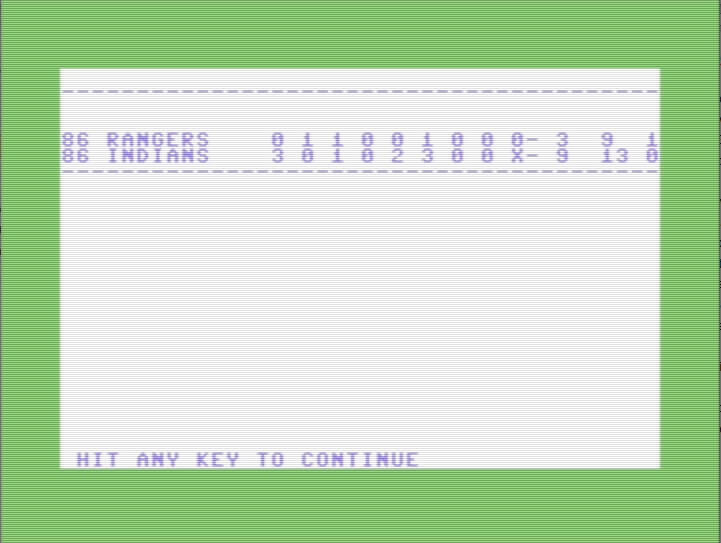
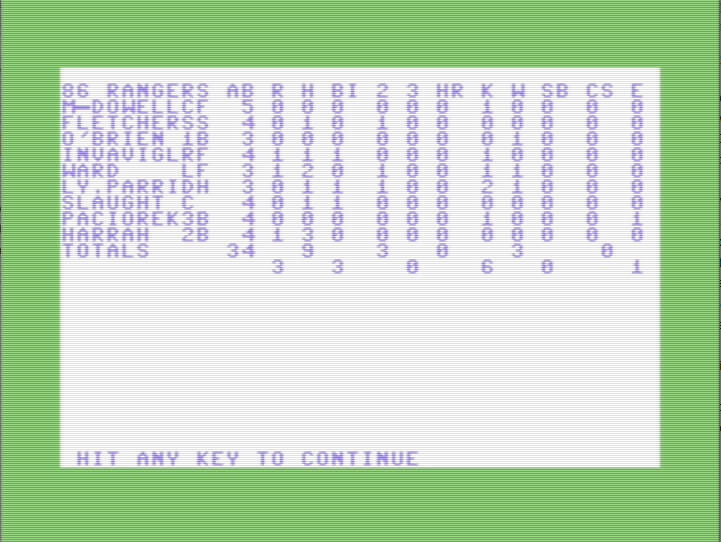
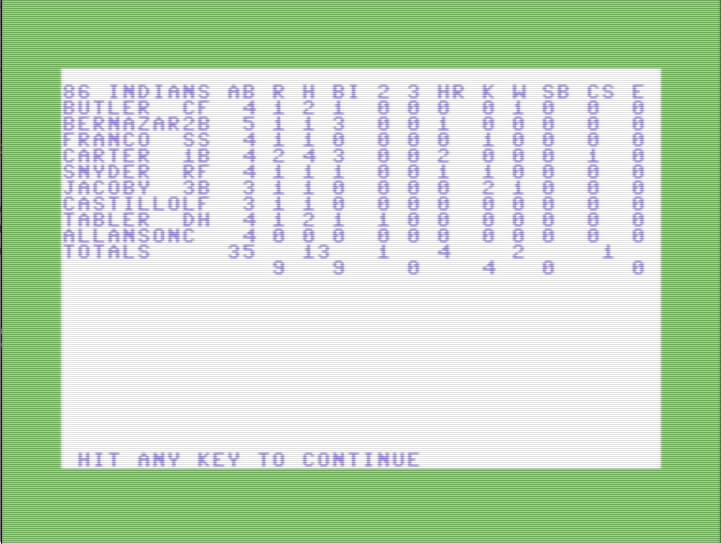
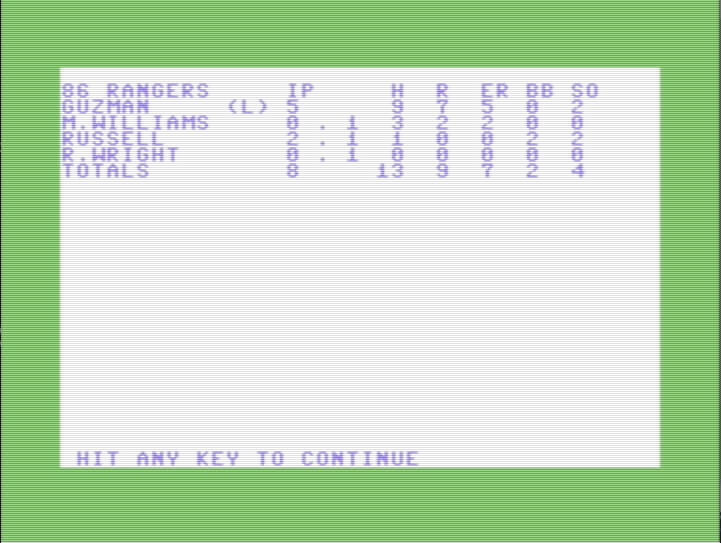
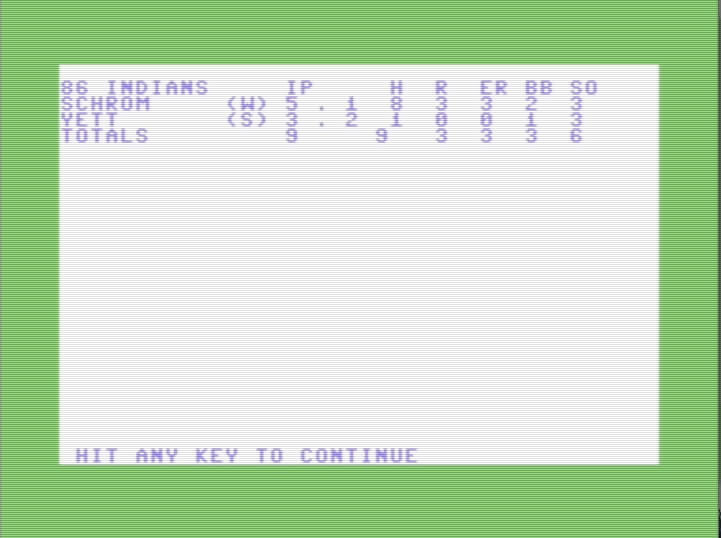
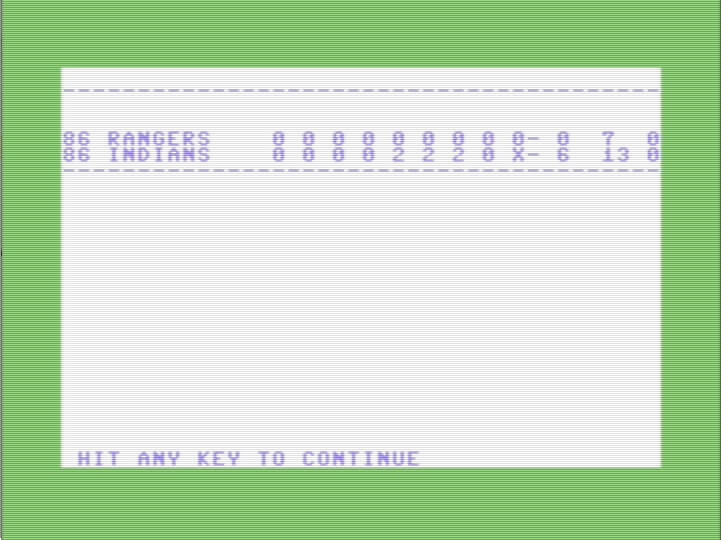
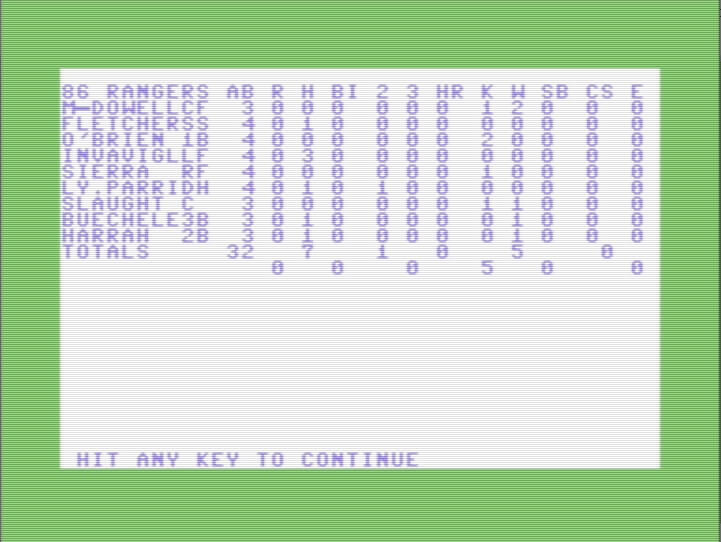
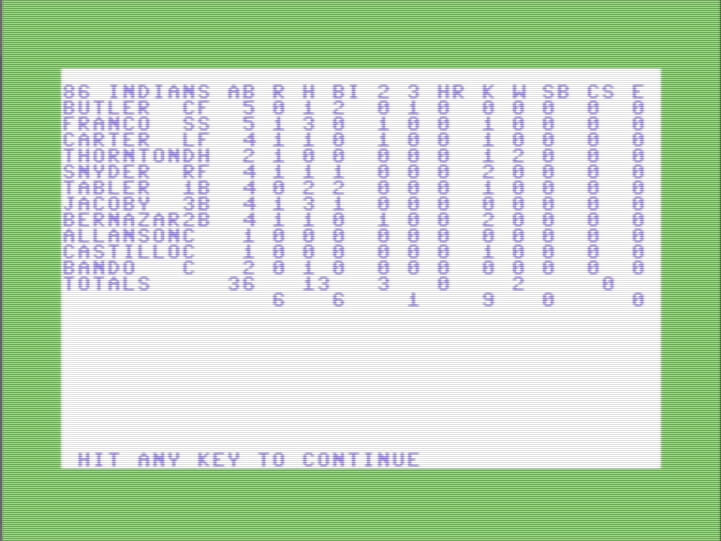
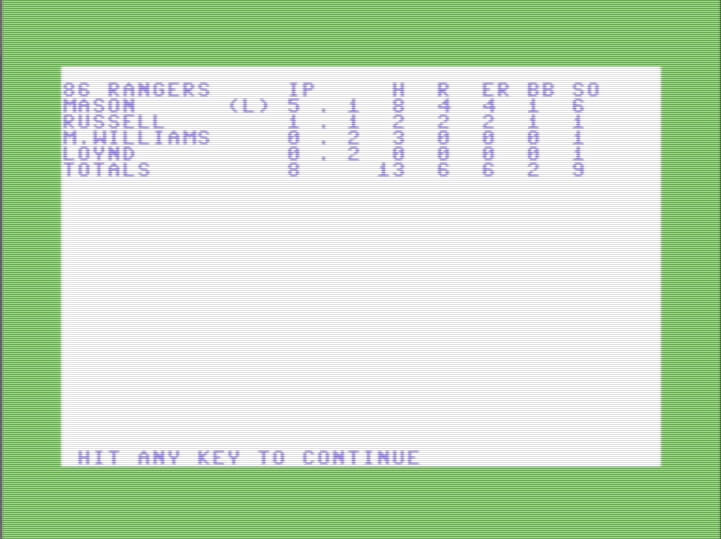
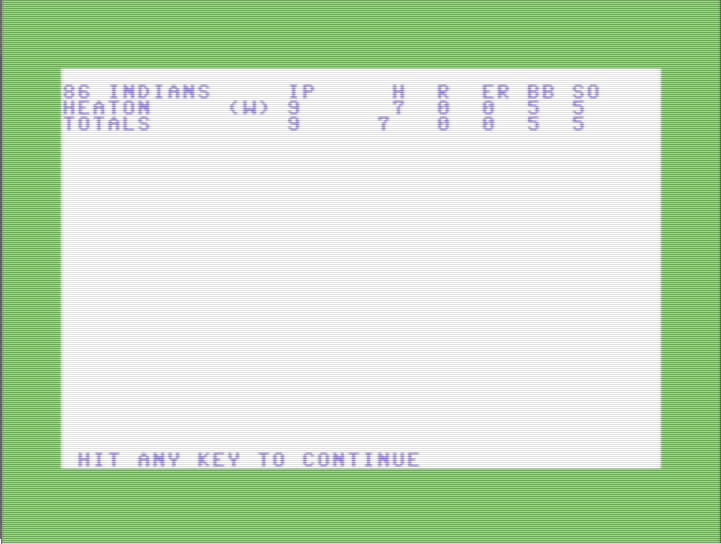
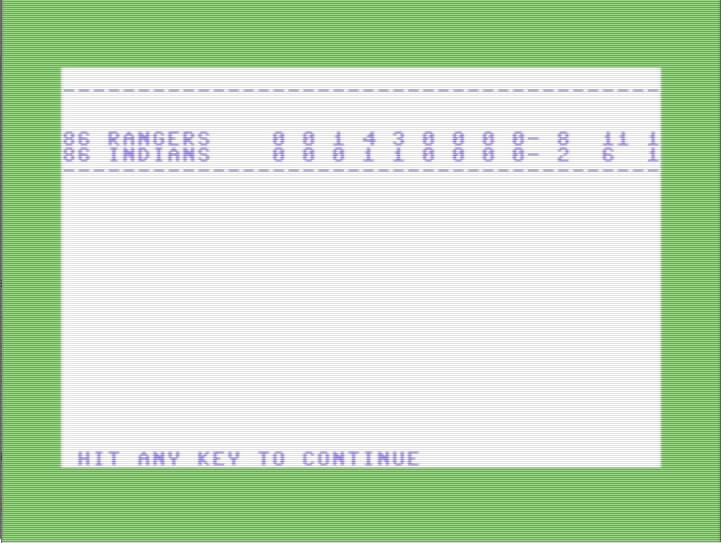
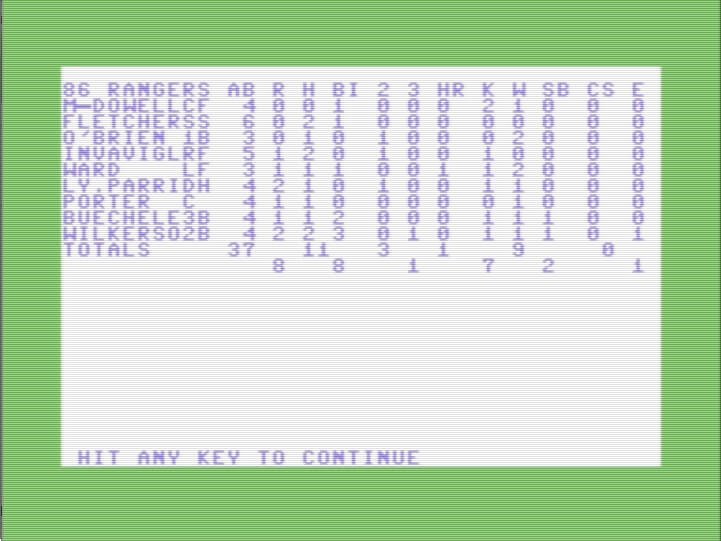
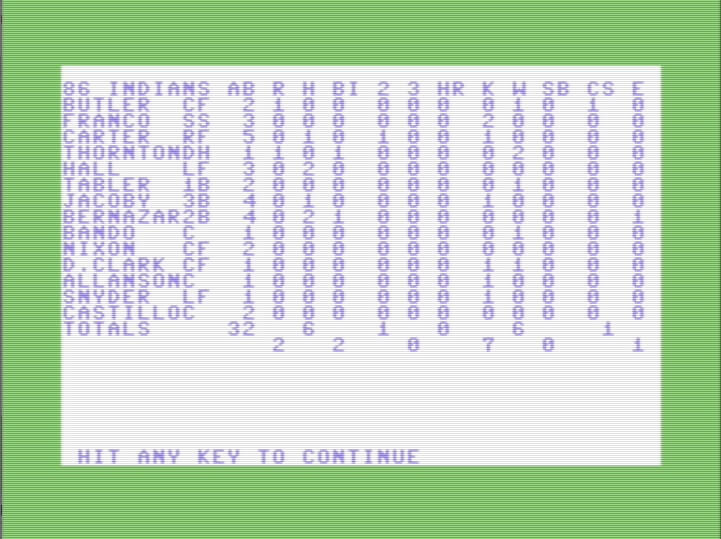
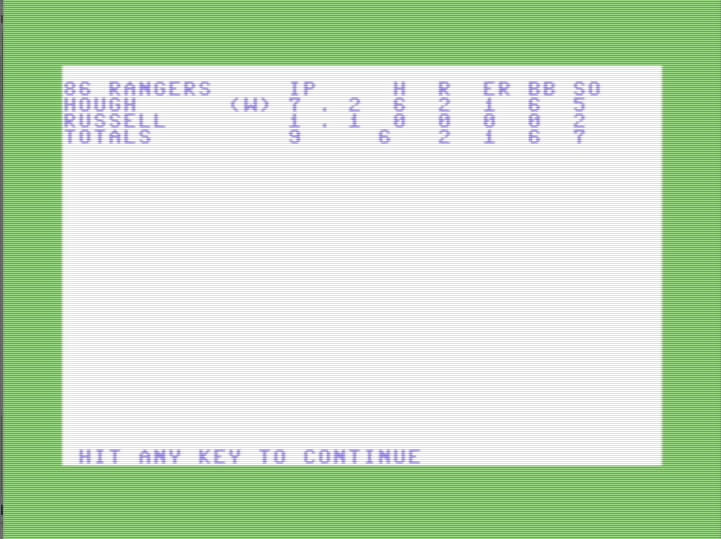
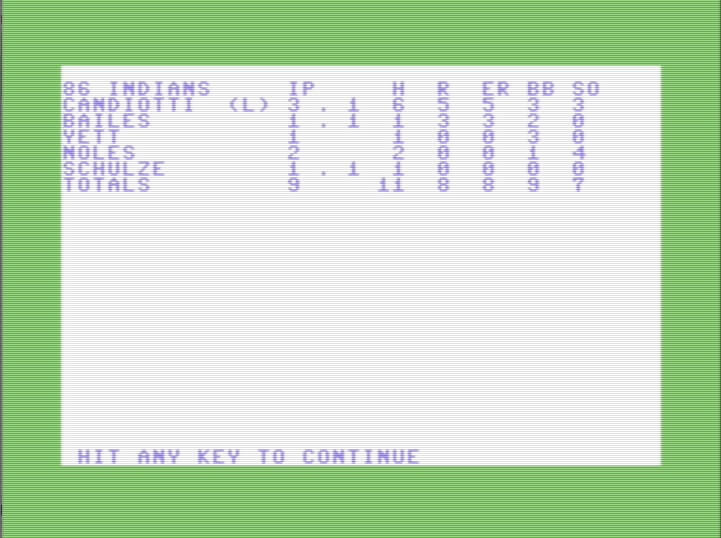
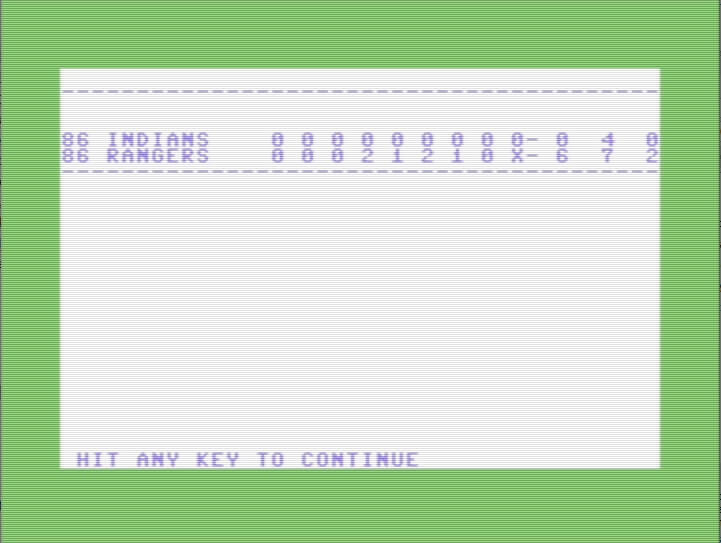
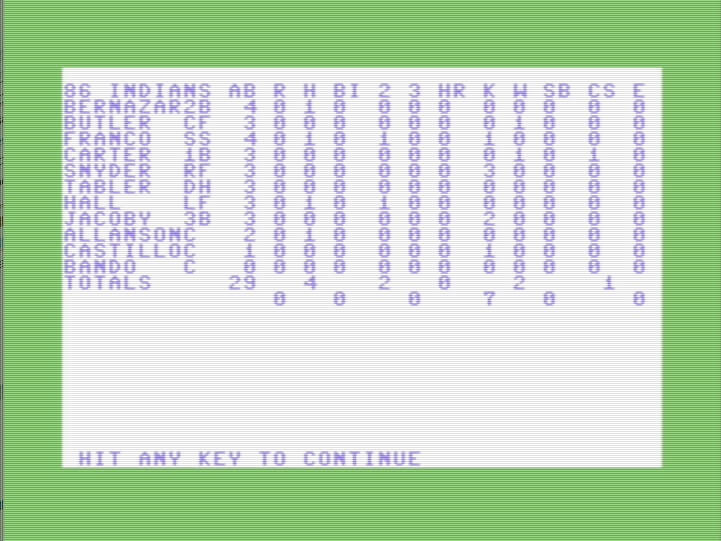
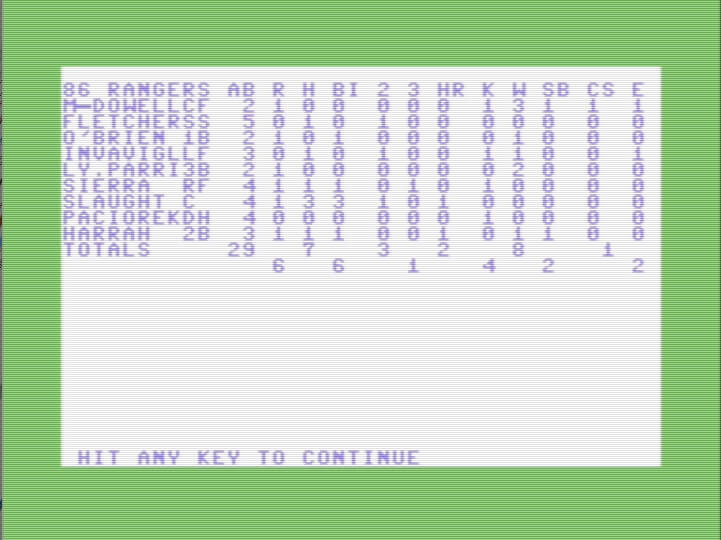
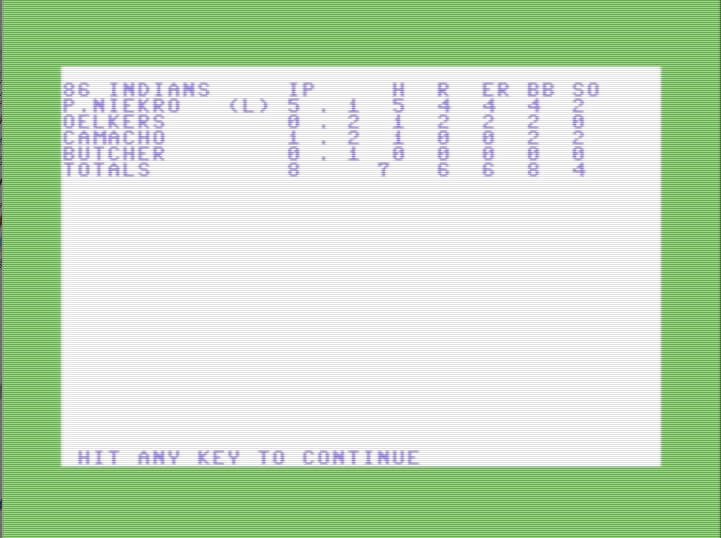
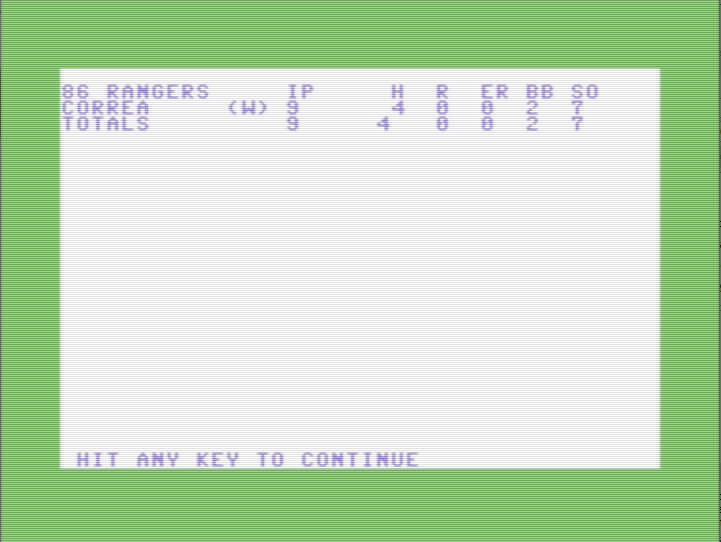
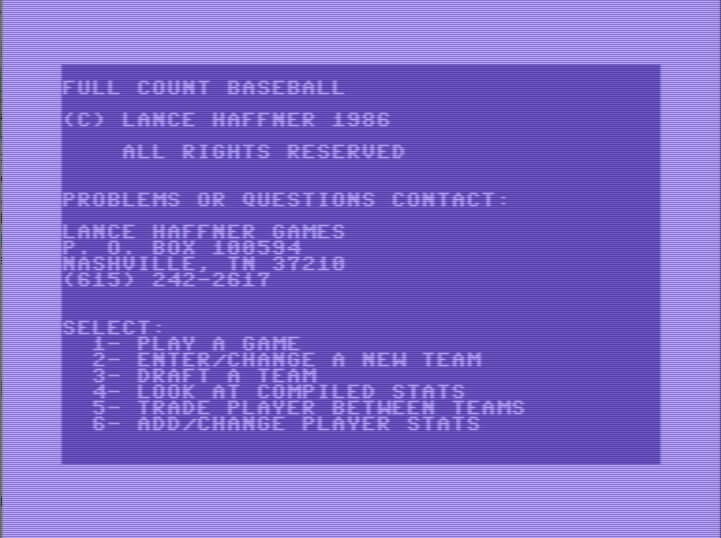
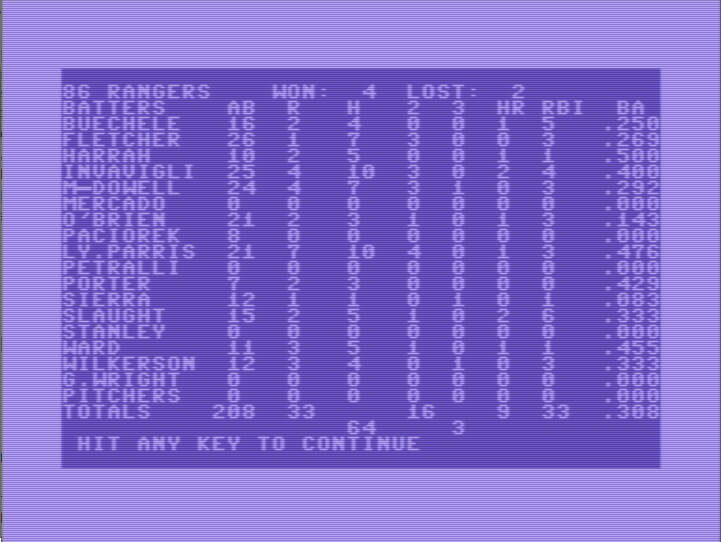
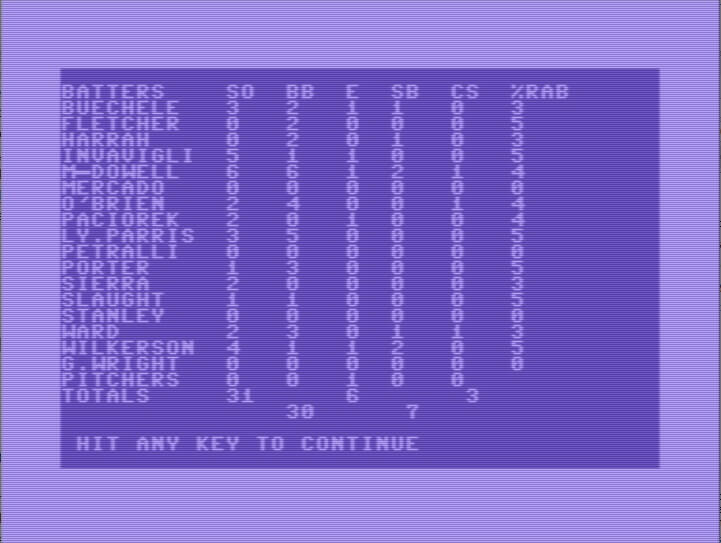
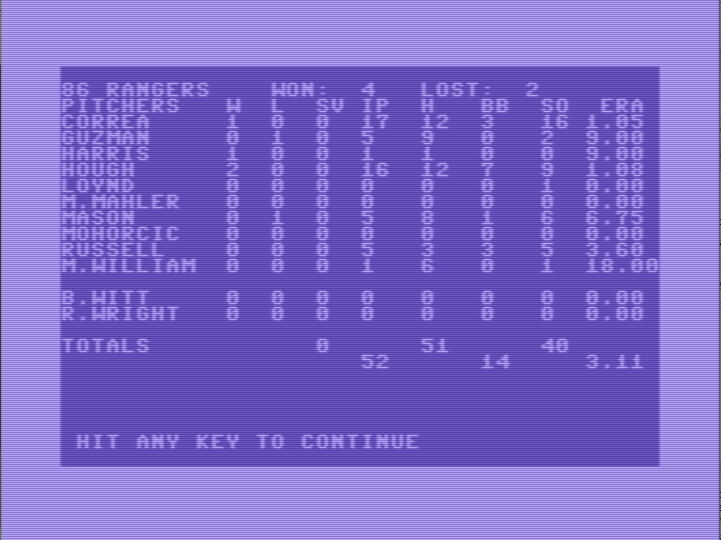
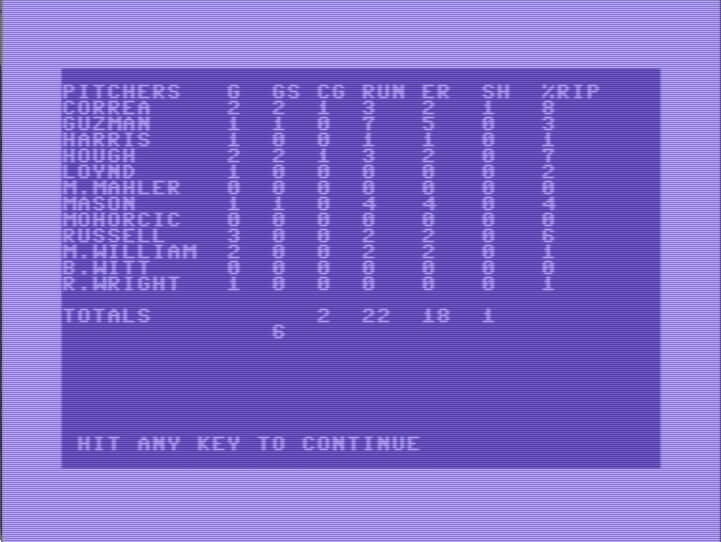

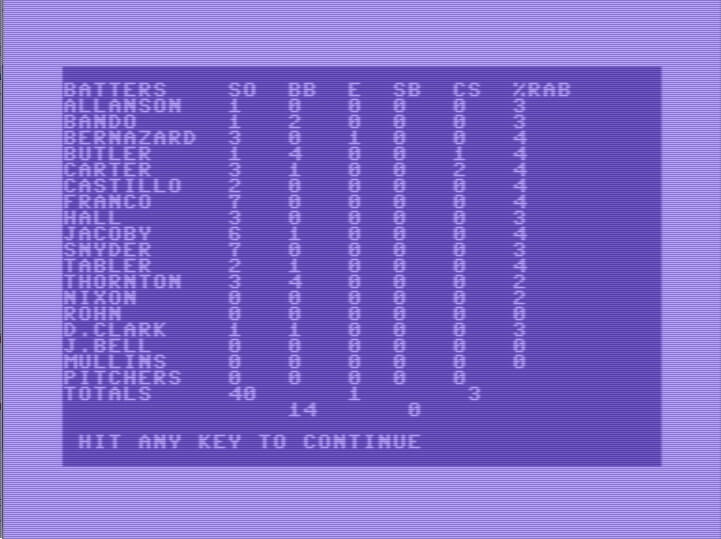
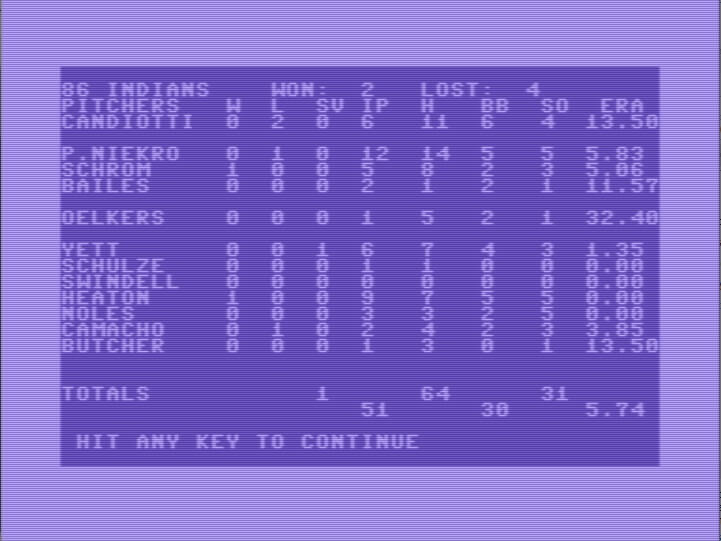
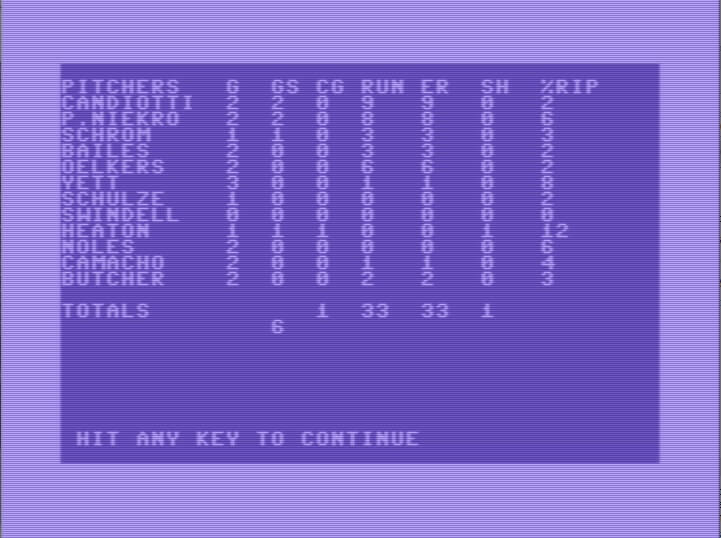
Full Count Baseball 6.0
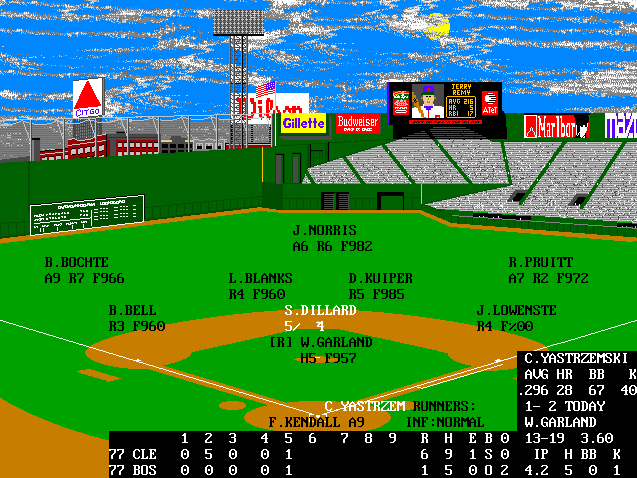
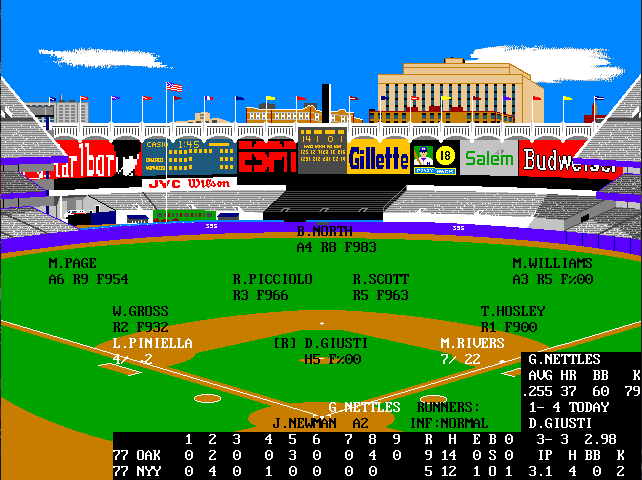
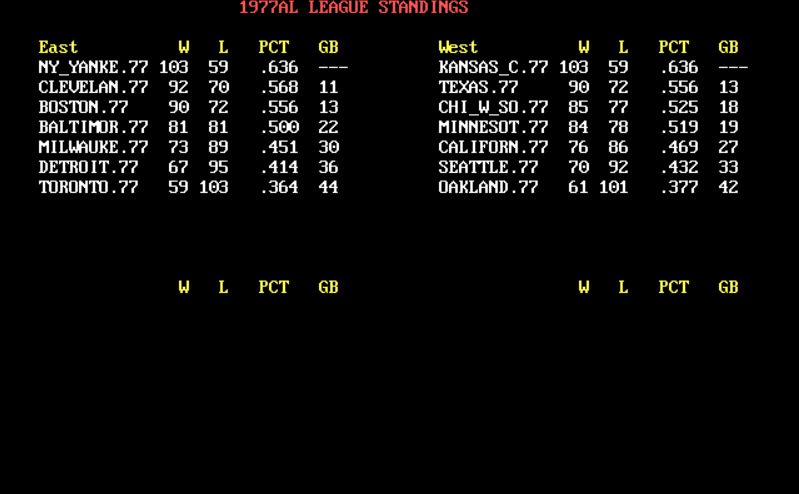
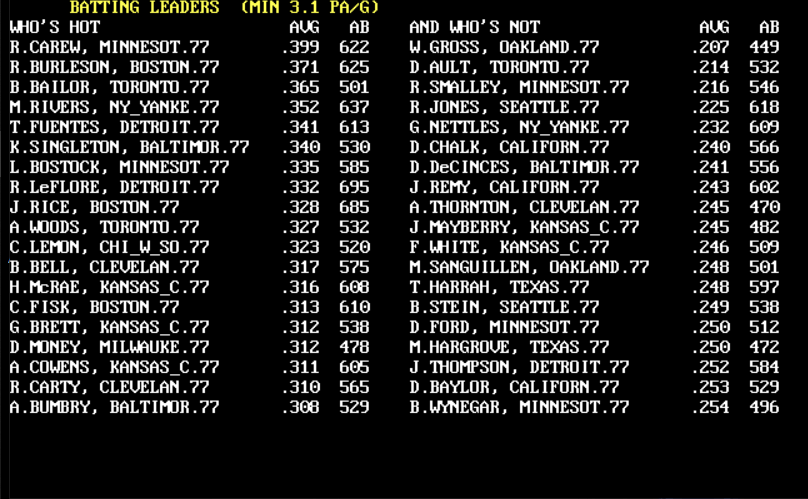
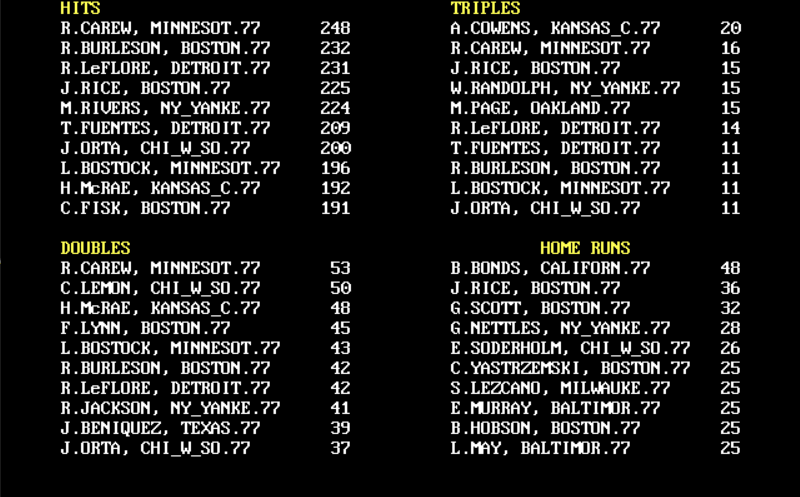
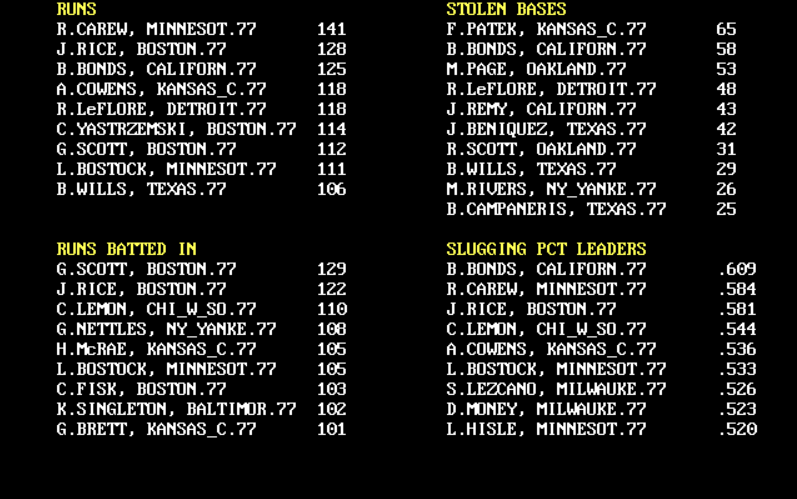
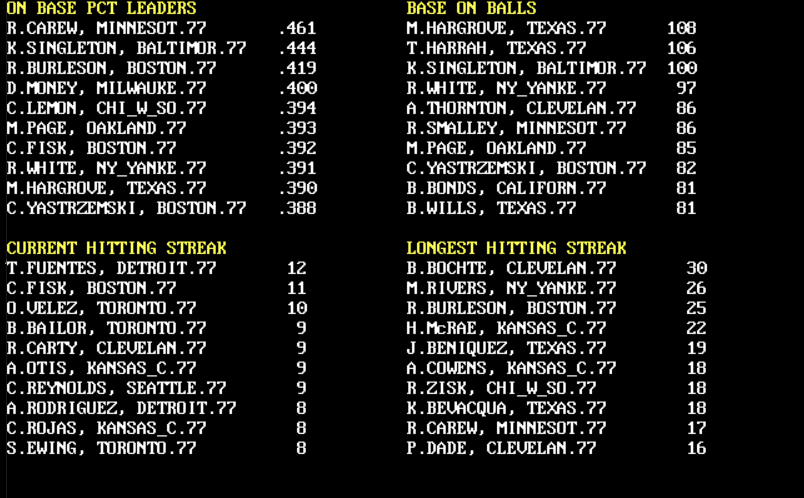
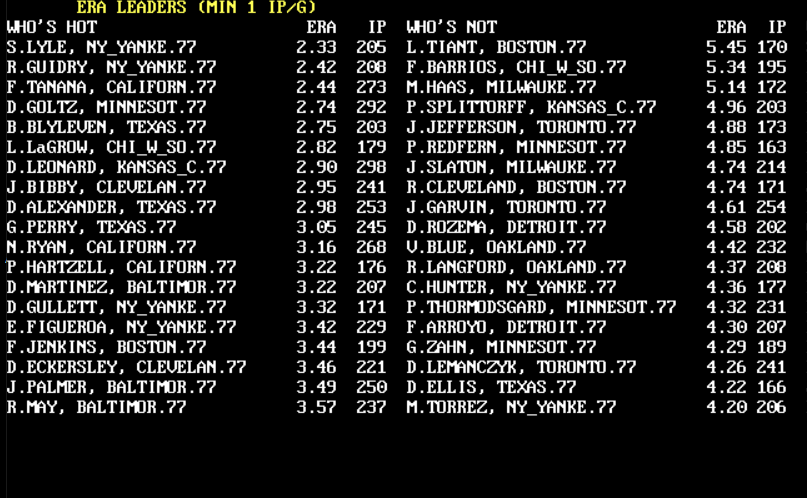
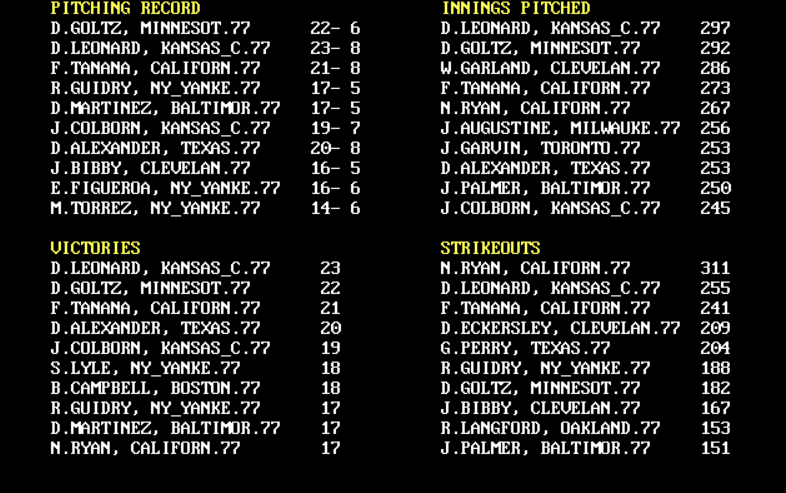
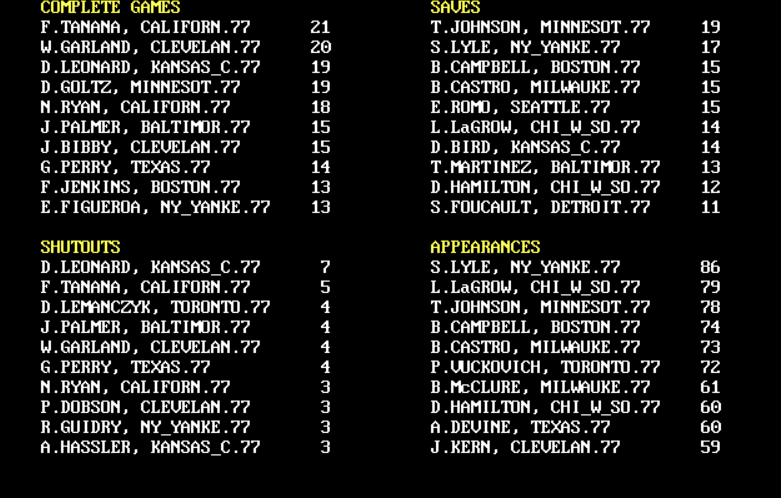
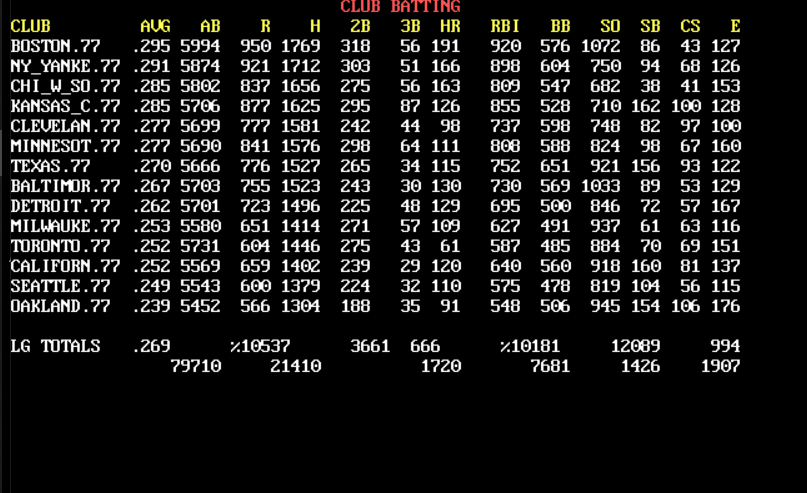
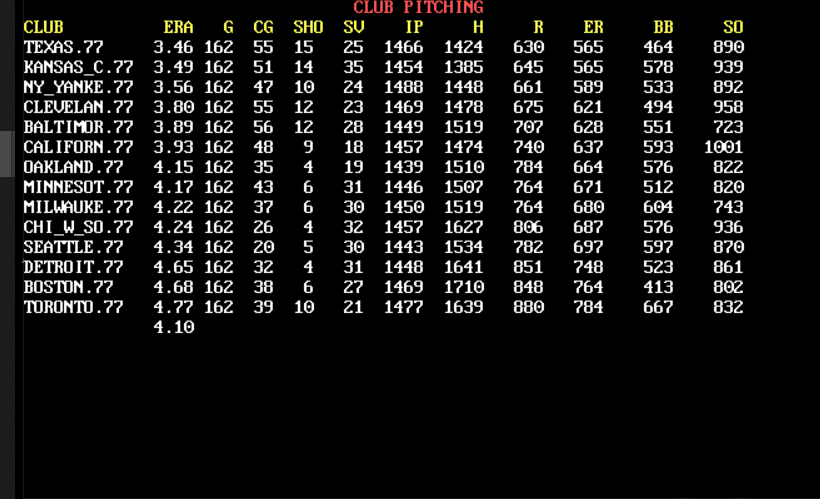
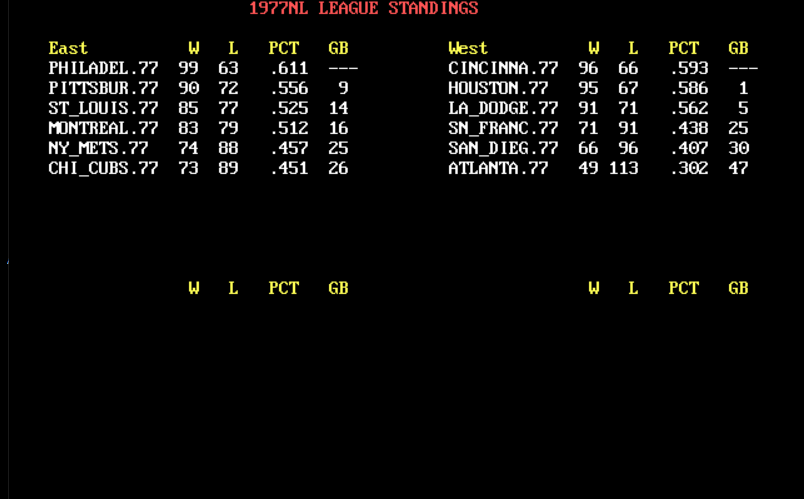
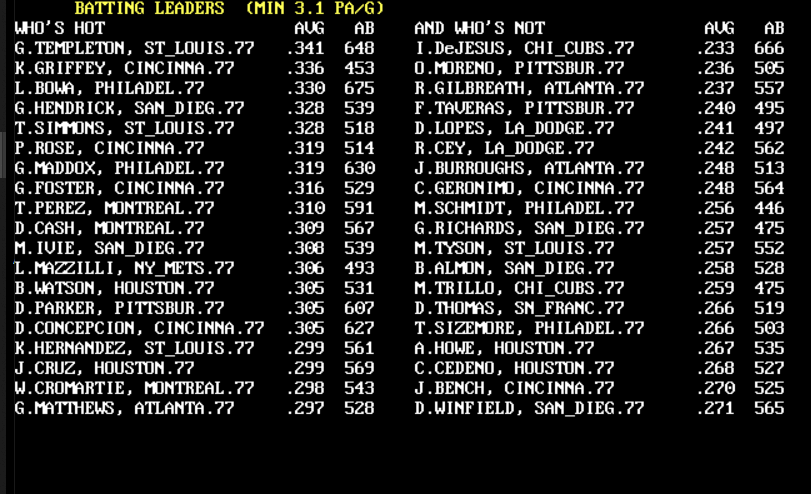
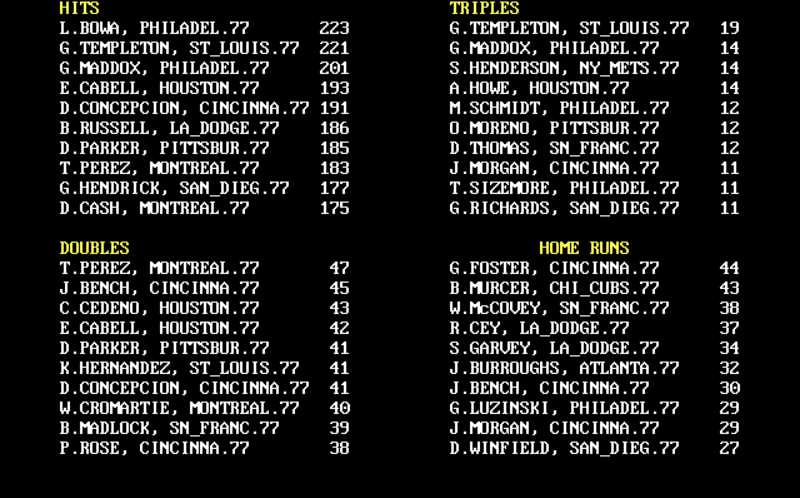
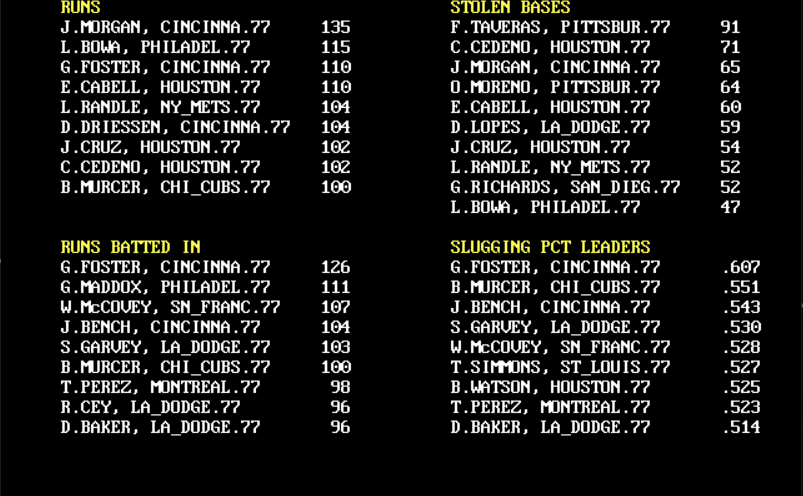
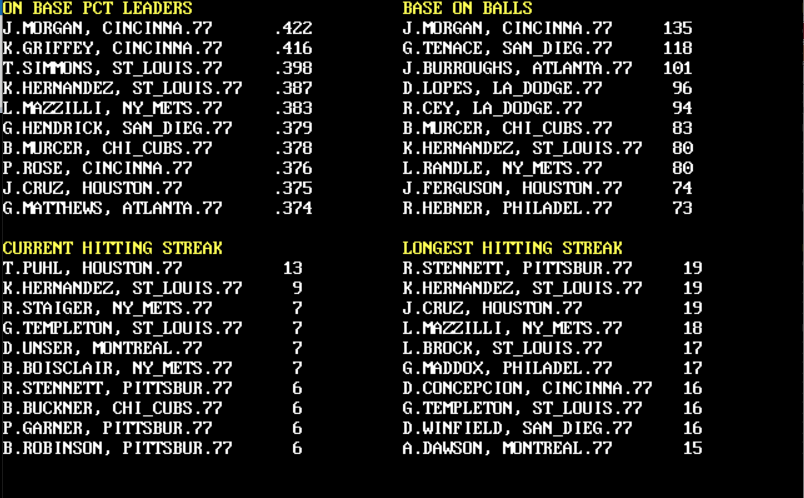
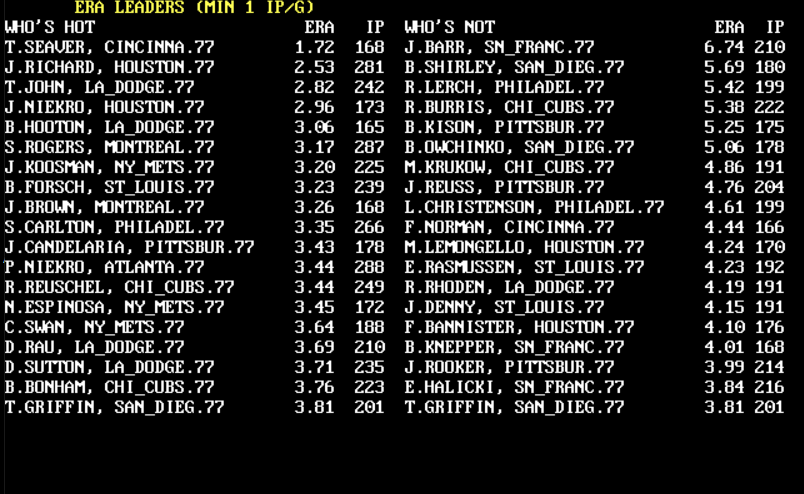
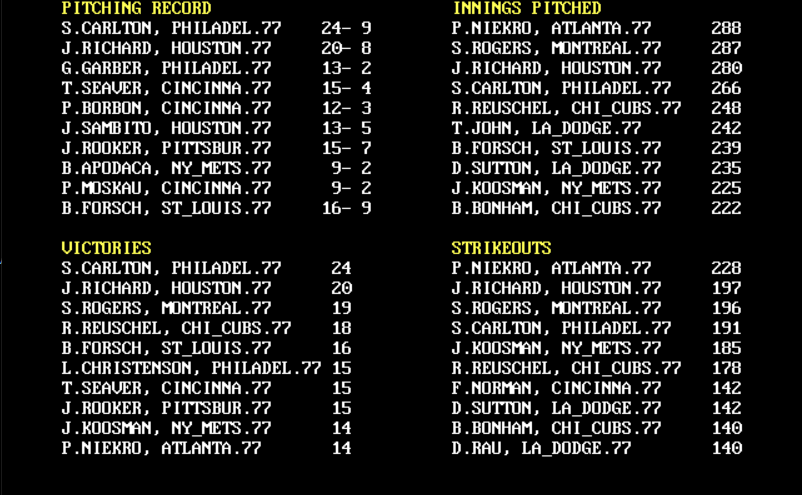
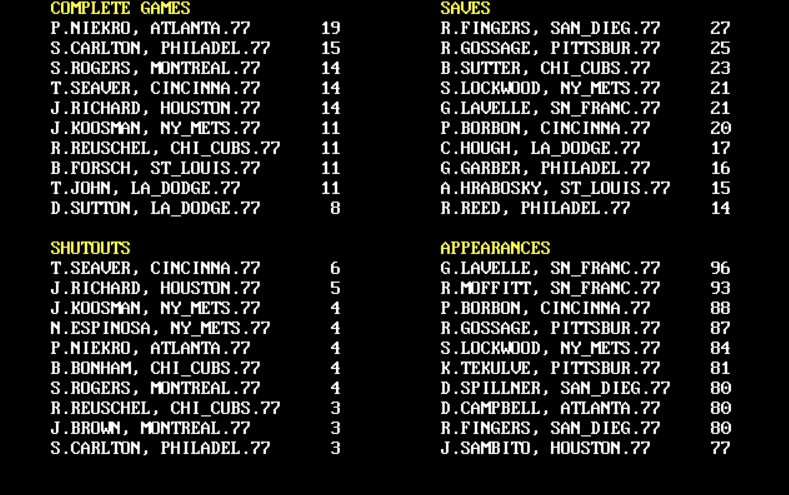
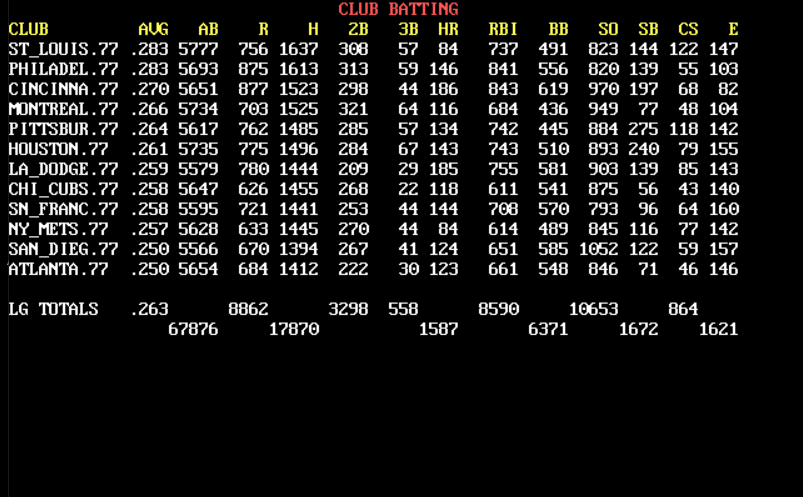
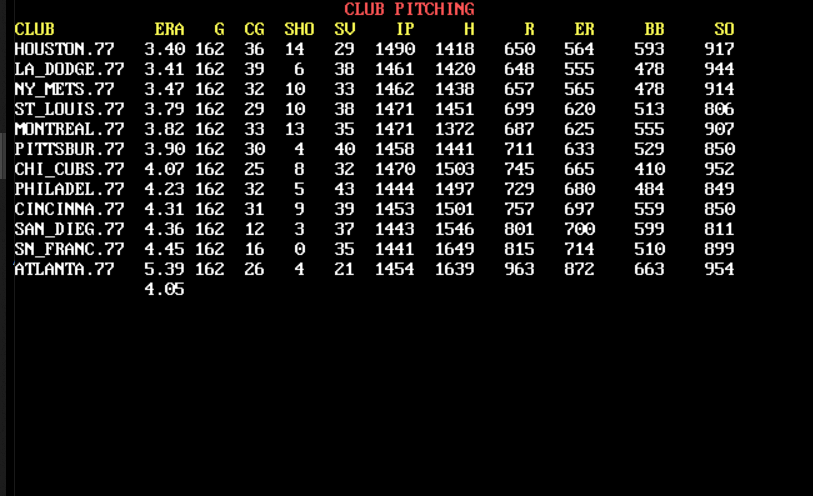
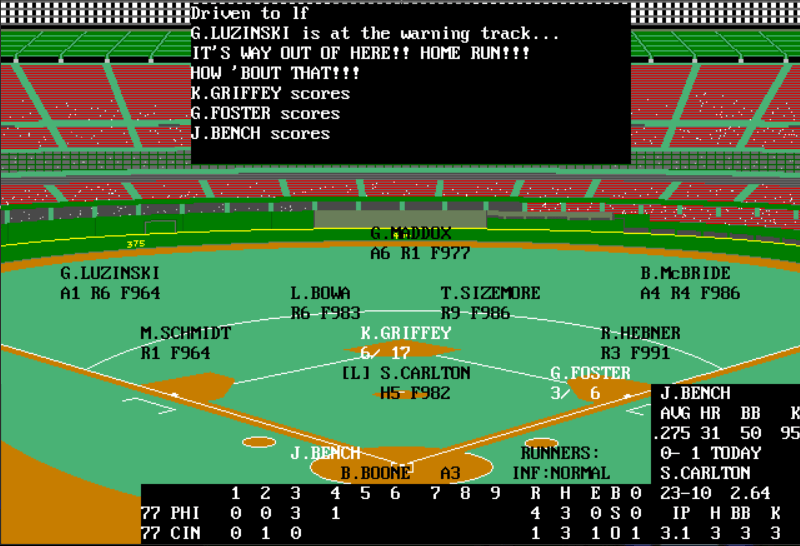
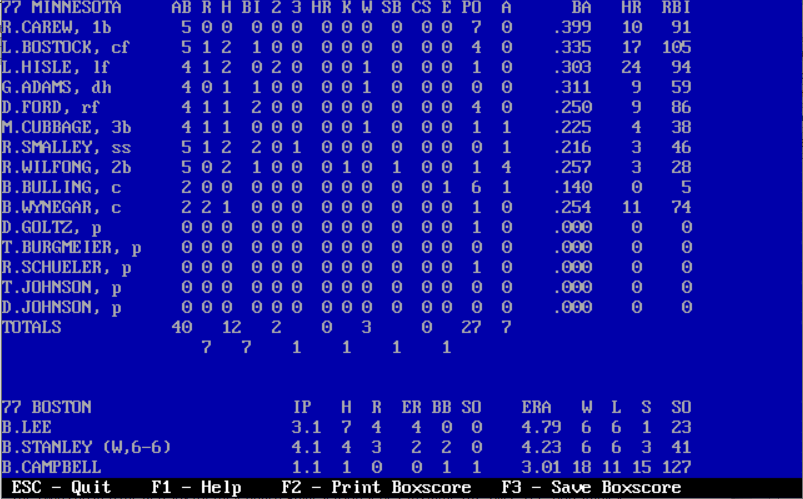
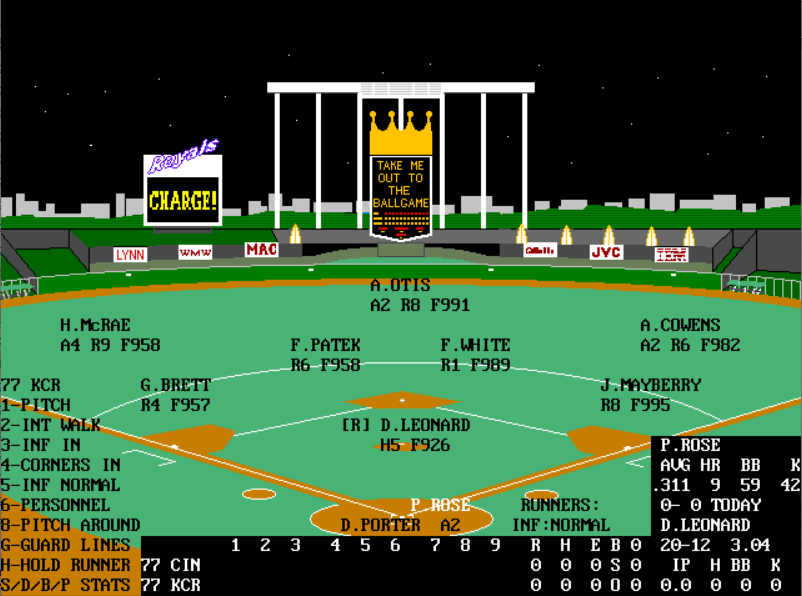
Articles in the Series
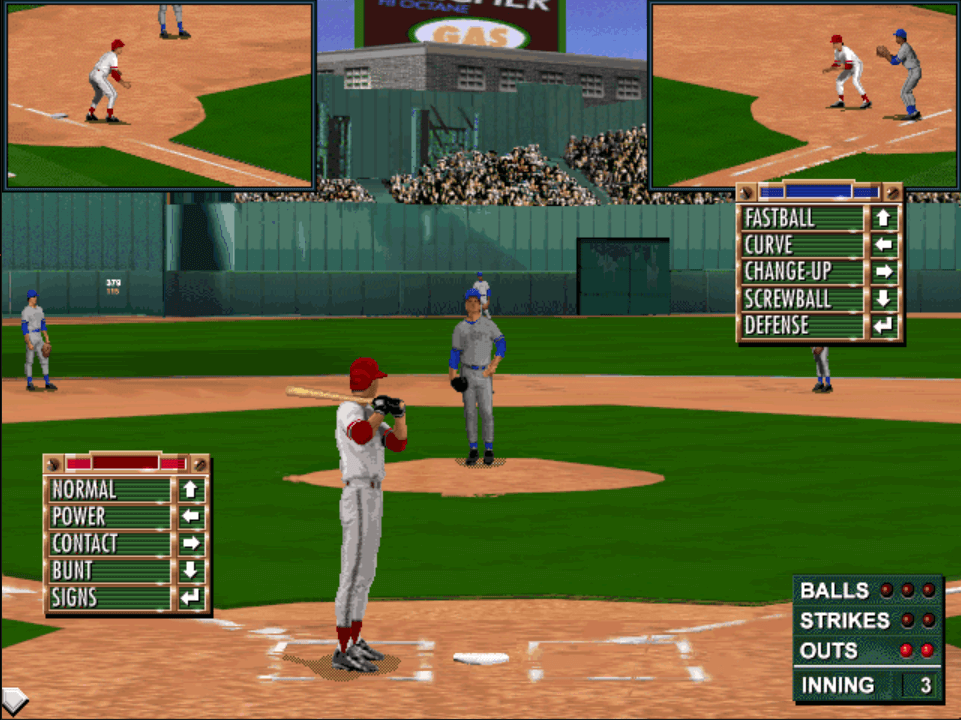 Retro Computer Baseball Game Review – Tony La Russa Baseball 3 – 4 – Old Time Baseball
Retro Computer Baseball Game Review – Tony La Russa Baseball 3 – 4 – Old Time Baseball
Additional Links
Full Count Baseball 6.0 – https://archive.org/details/msdos_Full_Count_Baseball_1994
Playthrough – HardballRetro
Fisher, Lew and Eric Faust. “Full Count Baseball.” Computer Gaming World. Volume 37, May 1987, p26. http://www.cgwmuseum.org/galleries/issues/cgw_37.pdf
McCauley, Dennis. “Atop the Mound: Baseball Slides Head-First Into Your PC”. Computer Gaming World. July 1996. p76. http://www.cgwmuseum.org/galleries/issues/cgw_144.pdf
Trunzo, James V. “Lance Haffner Games.” Compute! Issue 83, April 1987, p66. https://archive.org/details/1987-04-compute-magazine
https://www.mobygames.com/game/pc-booter/full-count-baseball
About the Author
I am a New Jersey native with a passion for baseball, statistics, computers and video games who enjoys spending quality time with his family.
“Hardball Architects – Volume 1 (American League)“, published in July 2020 and
“Hardball Architects – Volume 2 (National League)”, published in April 2022, examine the trades, free agent acquisitions, draft picks and other transactions for the 30 Major League Baseball franchises, divided into a 2-volume set. Both books are available in paperback and digital (Kindle) format at Amazon.com. All key moves are scrutinized for every team and Sabermetric principles are applied to the roster construction throughout the lifetime of the organization to encapsulate the hits and misses by front office executives. Team performances are analyzed based on transaction type with graphs depicting the WAR (Wins Above Replacement) in every decade. Individual results for each player-transaction is charted over the duration of their stint with the franchise. Every team chapter includes All-Time Rosters and Single-Season Leaders based on transaction type. The Team Trade Record chronicles the WAR and WS (Win Shares) accumulated by players acquired in comparison to those traded to opposing teams. The opening chapter is devoted to the Evolution of the General Manager and incorporates a discussion with former Dodgers GM Fred Claire (along with former Angels and Red Sox GM Mike Port and current Reds GM Nick Krall in Volume 2) on a variety of front office topics.
“Hardball Retroactive”, published in June 2018, is available in paperback and digital (Kindle) format at Amazon.com. Hardball Retroactive is a modest collection of selected articles that I have written for Seamheads.com along with my Baseball Analytics blog since 2010. Exclusive content includes the chapter on “Minors vs. Majors” which assesses every franchise’s minor league successes and failures in relation to their major league operations.
“Hardball Retrospective” is available in paperback and digital (Kindle) format at Amazon.com. Supplemental Statistics, Charts and Graphs along with a discussion forum are offered at TuataraSoftware.com. In Hardball Retrospective, I placed every ballplayer in the modern era (from 1901-present) on their original teams. Using a variety of advanced statistics and methods, I generated revised standings for each season based entirely on the performance of each team’s “original” players. I discuss every team’s “original” players and seasons at length along with organizational performance with respect to the Amateur Draft (or First-Year Player Draft), amateur free agent signings and other methods of player acquisition. Season standings, WAR and Win Shares totals for the “original” teams are compared against the real-time or “actual” team results to assess each franchise’s scouting, development and general management skills.
Don Daglow (Intellivision World Series Major League Baseball, Earl Weaver Baseball, Tony LaRussa Baseball) contributed the foreword for Hardball Retrospective. The foreword and preview of my book are accessible here.
“Hardball Retrospective – Addendum 2014 to 2016” supplements my research for Hardball Retrospective, providing retroactive standings based on Wins Above Replacement (WAR) and Win Shares (WS) for each “original” team over the past three seasons (2014-2016). Team totals from 2010 – 2013 are included for reference purposes. “Addendum” is available in paperback and digital (Kindle) format at Amazon.com.
The current article reflects revisions posted in August 2022:
- Full Count Baseball 6.0 credits, review, ratings, screenshots, additional links
- interview with programmer and designer Lance Haffner
NOTE: Original article posted on the Hardball Retro website, January 25, 2020.
A lifelong resident of central New Jersey, I enjoy spending quality time with my wife and three children. In my professional life I’ve worked for three local healthcare systems as a server and network administrator over the last 30 years. Co-chair of the SABR Games and Simulations Committee since August 2022 along with Mark Wendling.
My hobbies include baseball, statistics, computers and video games along with freshwater fishing. I have authored five books and contributed articles to Seamheads, Fangraphs and my site, Hardball Retro. Follow my HardballRetro channels on Twitch for live-streaming of classic and current baseball video games and view the resulting playthrough videos on YouTube!
Visit my Amazon author page to check out my books, promotional videos, and post a review if you're a Hardball Retro fan!
My Books:
"Hardball Retro’s Compendium of Baseball Video Games and Electronic Handhelds," published in September 2024 with co-author John Racanelli, is available in paperback and digital (Kindle) format at Amazon.com.Hardball Retro’s Compendium of Baseball Video Games and Electronic Handhelds was recognized with the 2025 Sporting News-SABR Baseball Research Award.
“Hardball Architects – Volume 1 (American League Teams)”,published in July 2020, is available in paperback and digital (Kindle) format at Amazon.com.
“Hardball Architects – Volume 2 (National League Teams)”,published in April 2022, is available in paperback and digital (Kindle) format at Amazon.com.
“Hardball Architects” examines the trades, free agent acquisitions, draft picks and other transactions for the 30 Major League Baseball franchises, divided into a 2-volume set (American League and National League). All key moves are scrutinized for every team and Sabermetric principles are applied to the roster construction throughout the lifetime of the organization to encapsulate the hits and misses by front office executives.
“Hardball Retroactive”,published in June 2018, is available in paperback and digital (Kindle) format at Amazon.com. A cross-section of essays that I penned for Seamheads.com along with my Baseball Analytics blog spanning nearly a decade touching on subjects including "Taking the Extra Base", "General Manager Scorecard", "Worst Trades", "BABIP By Location" and "Baseball Birthplaces and the Retro World Baseball Classic". Rediscover your favorite hardball arcade and simulations in "Play Retro Baseball Video Games In Your Browser" or take a deep dive into every franchise's minor league successes and failures in relation to their major league operations in "Minors vs. Majors".
“Hardball Retrospective” is available in paperback and digital (Kindle) format at Amazon.com.Supplemental Statistics, Charts and Graphs along with a discussion forum are offered at TuataraSoftware.com. In Hardball Retrospective, I placed every ballplayer in the modern era (from 1901-present) on their original teams. Using a variety of advanced statistics and methods, I generated revised standings for each season based entirely on the performance of each team’s “original” players. I discuss every team’s “original” players and seasons at length along with organizational performance with respect to the Amateur Draft (or First-Year Player Draft), amateur free agent signings and other methods of player acquisition. Season standings, WAR and Win Shares totals for the “original” teams are compared against the real-time or “actual” team results to assess each franchise’s scouting, development and general management skills.
Don Daglow (Intellivision World Series Major League Baseball, Earl Weaver Baseball, Tony LaRussa Baseball) contributed the foreword for Hardball Retrospective. The foreword and preview of my book are accessible here.
“Hardball Retrospective - Addendum 2014 to 2016”supplements my research for Hardball Retrospective, providing retroactive standings based on Wins Above Replacement (WAR) and Win Shares (WS) for each "original" team over the past three seasons (2014-2016). Team totals from 2010 - 2013 are included for reference purposes. “Addendum” is available in paperback and digital (Kindle) format at Amazon.com.
Contact me on BlueSky - @hardballretro.bsky.social
- Derek Bainhttps://sabrbaseballgaming.com/author/dbain21/
- Derek Bainhttps://sabrbaseballgaming.com/author/dbain21/
- Derek Bainhttps://sabrbaseballgaming.com/author/dbain21/
- Derek Bainhttps://sabrbaseballgaming.com/author/dbain21/
